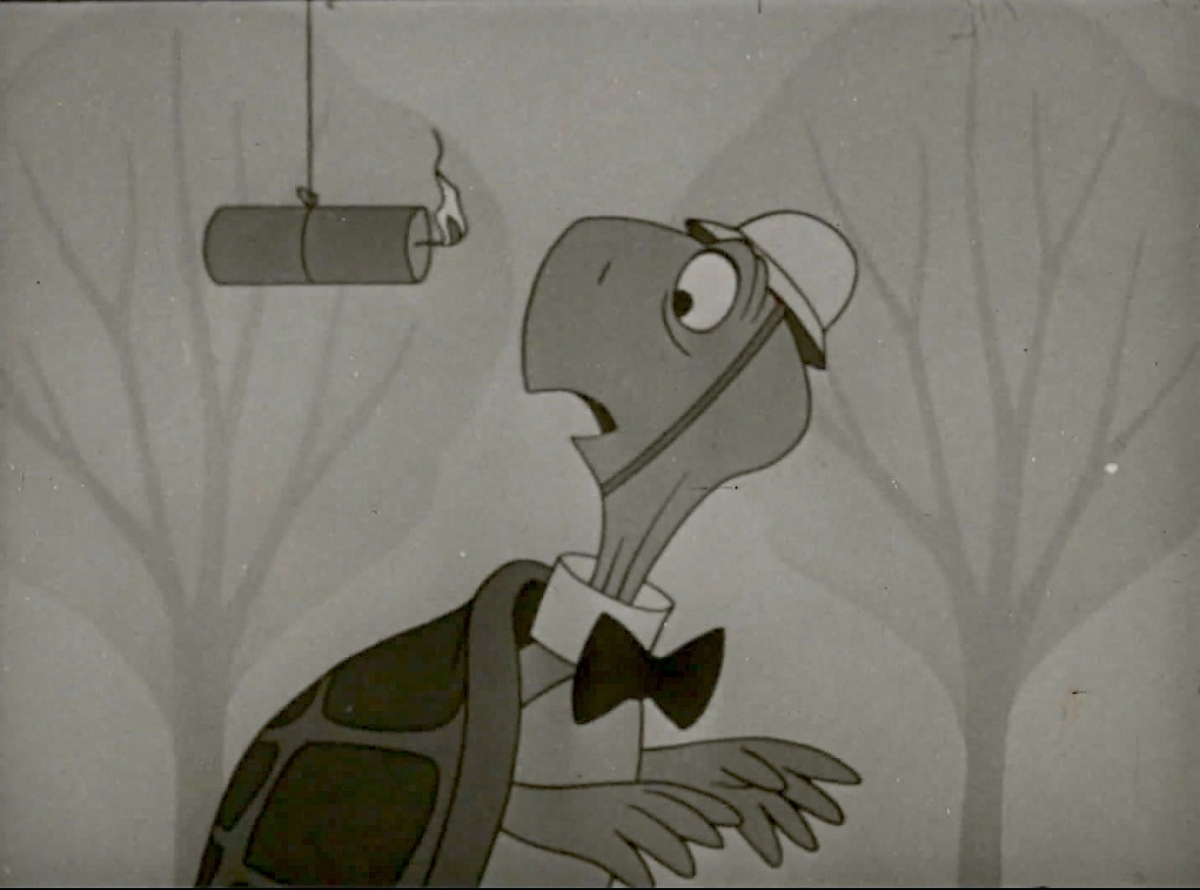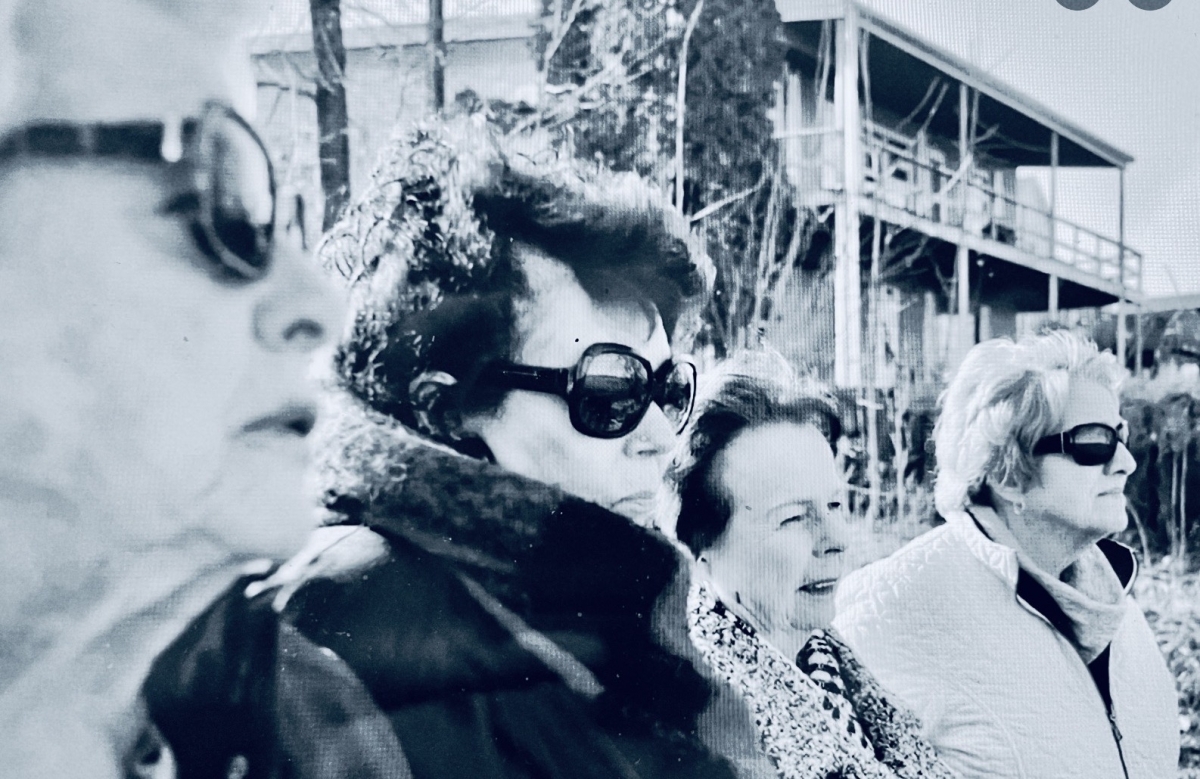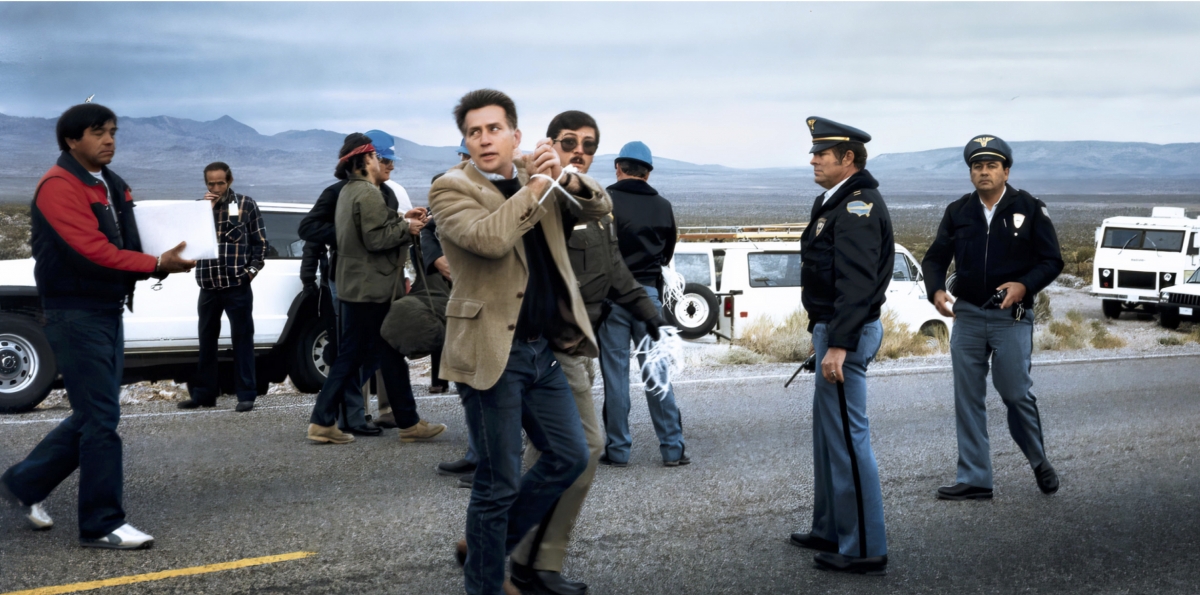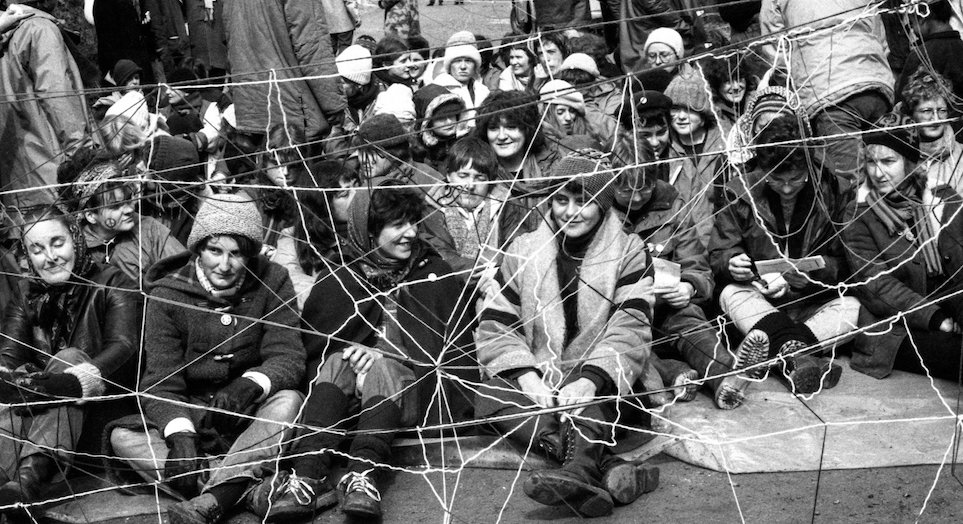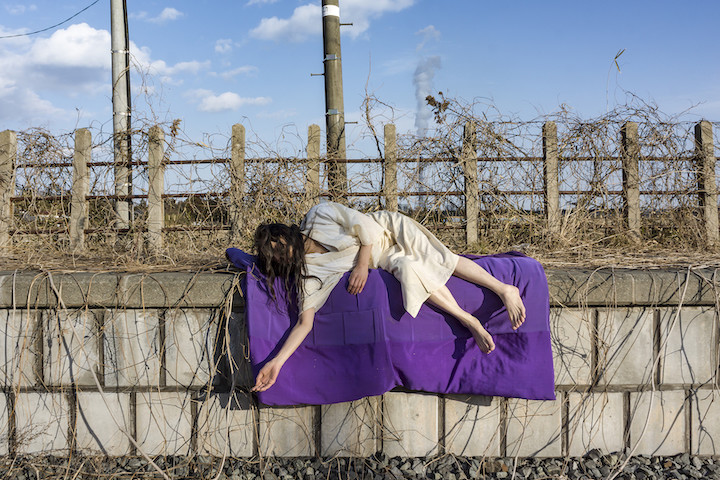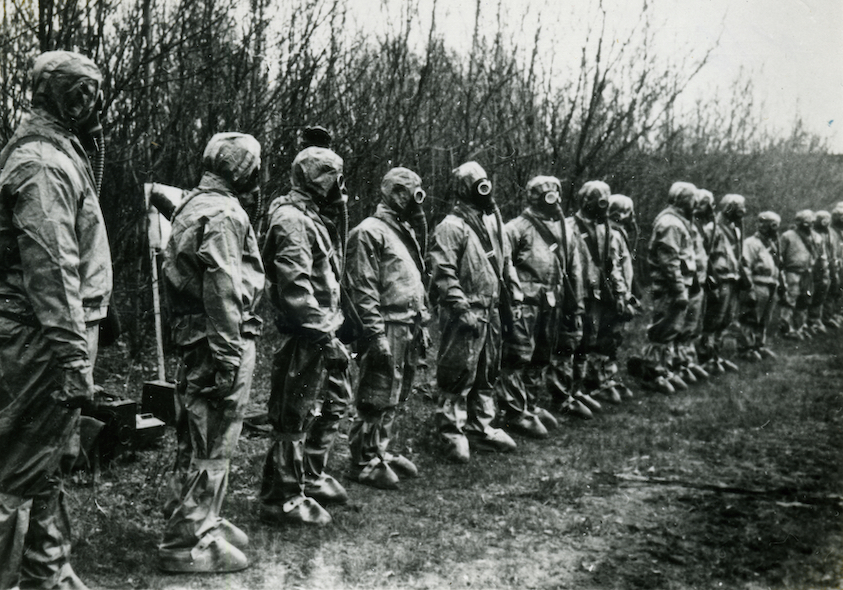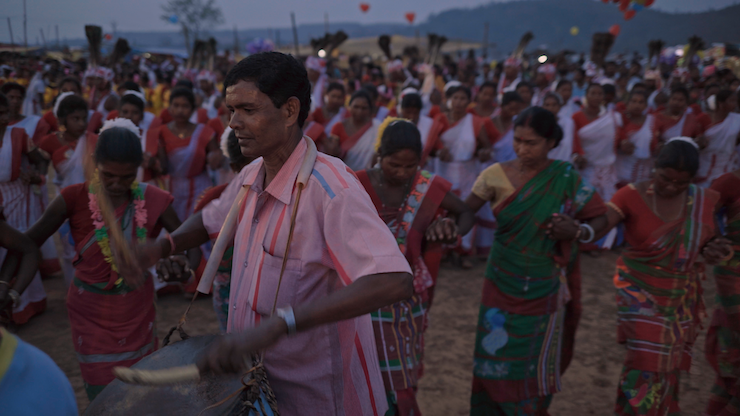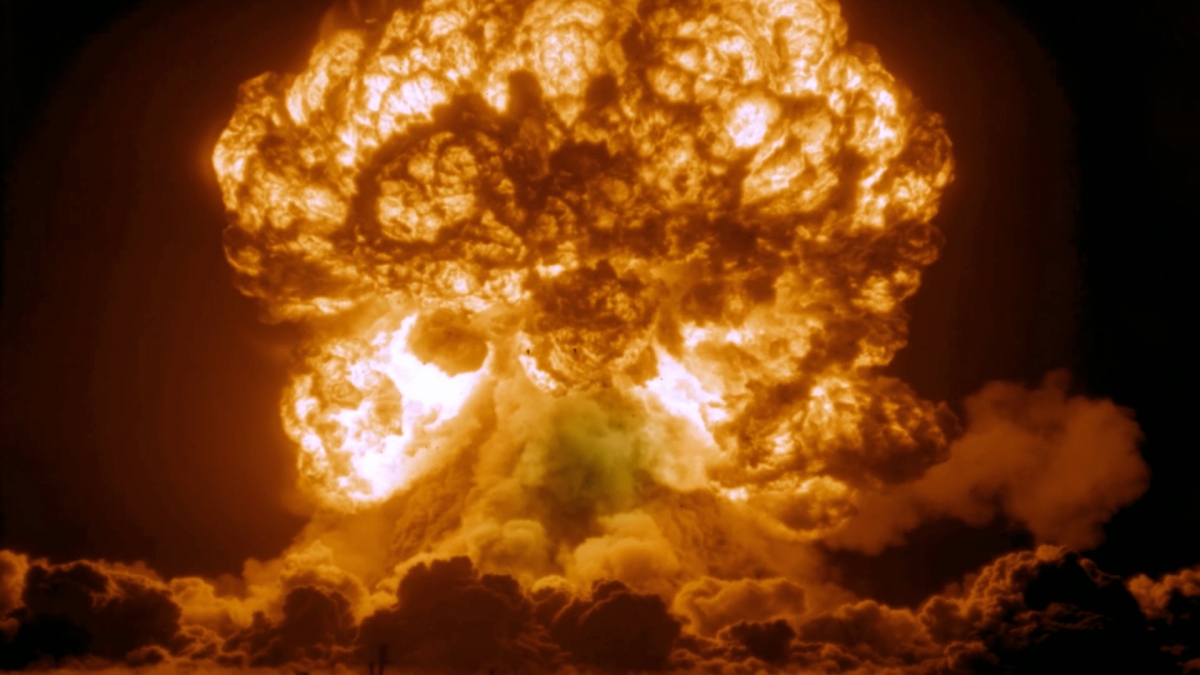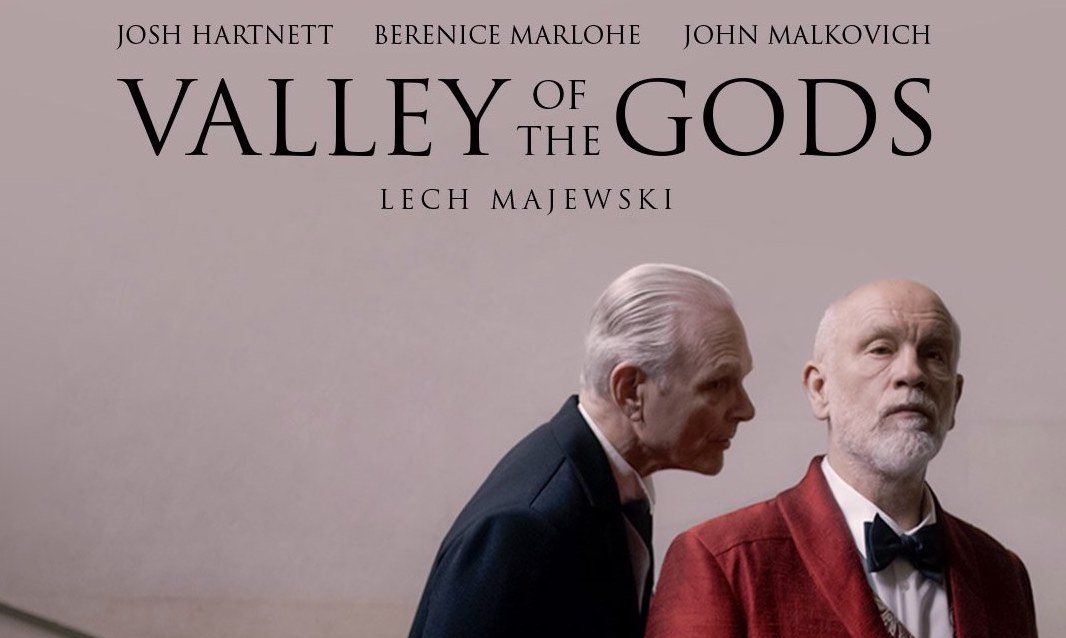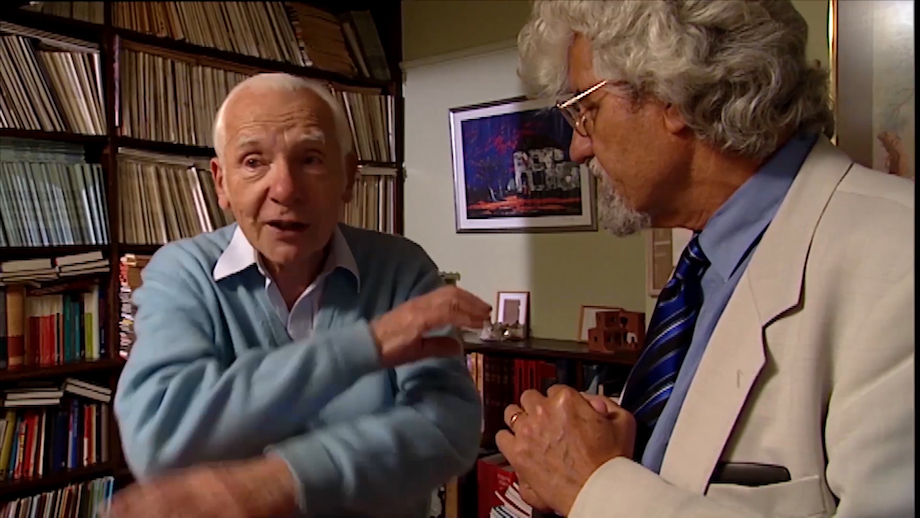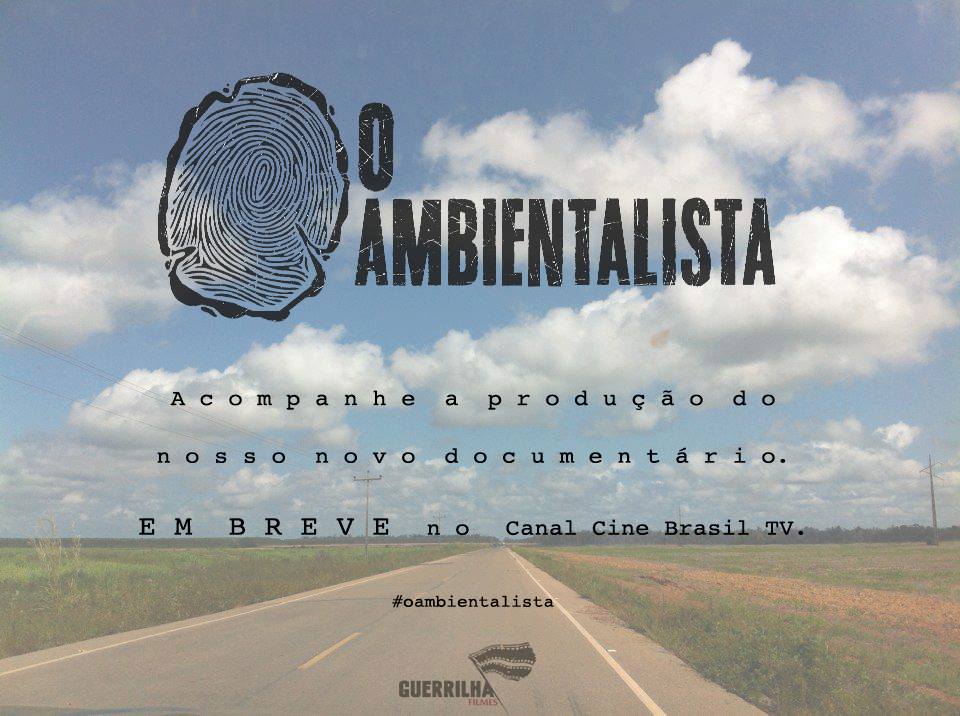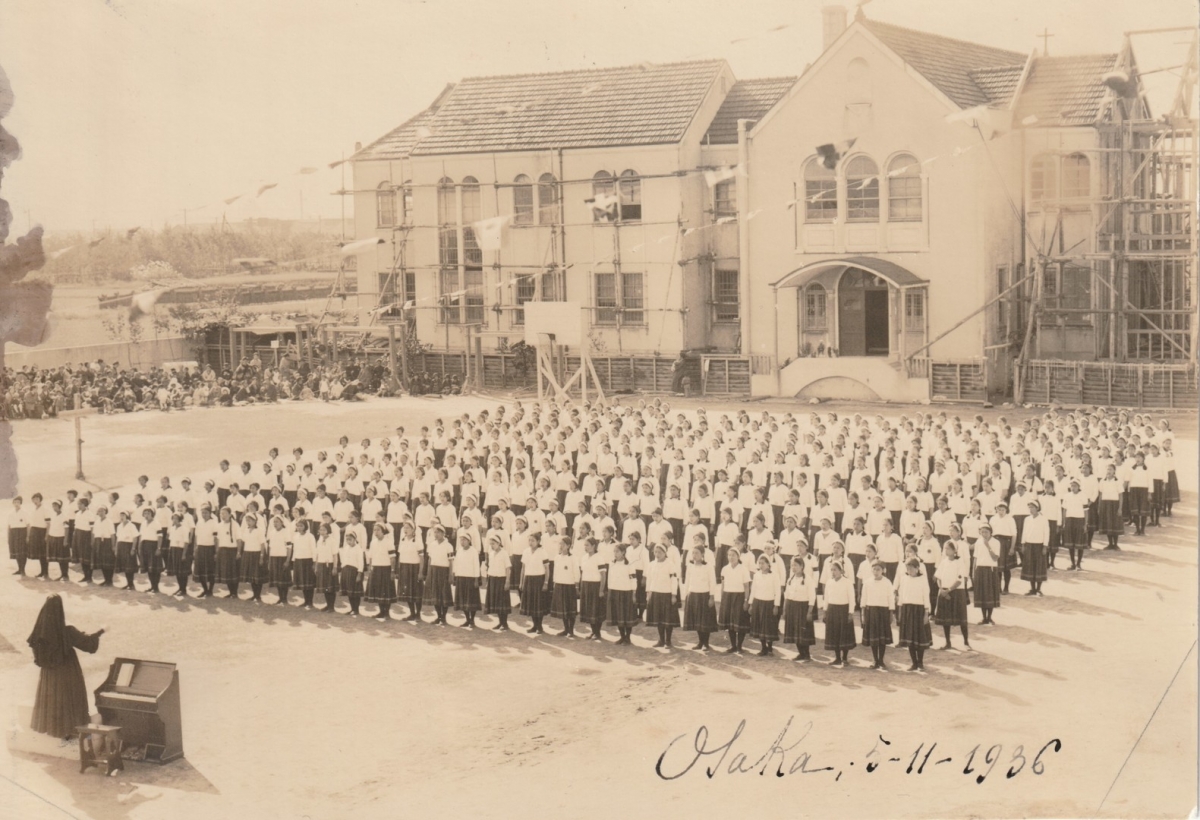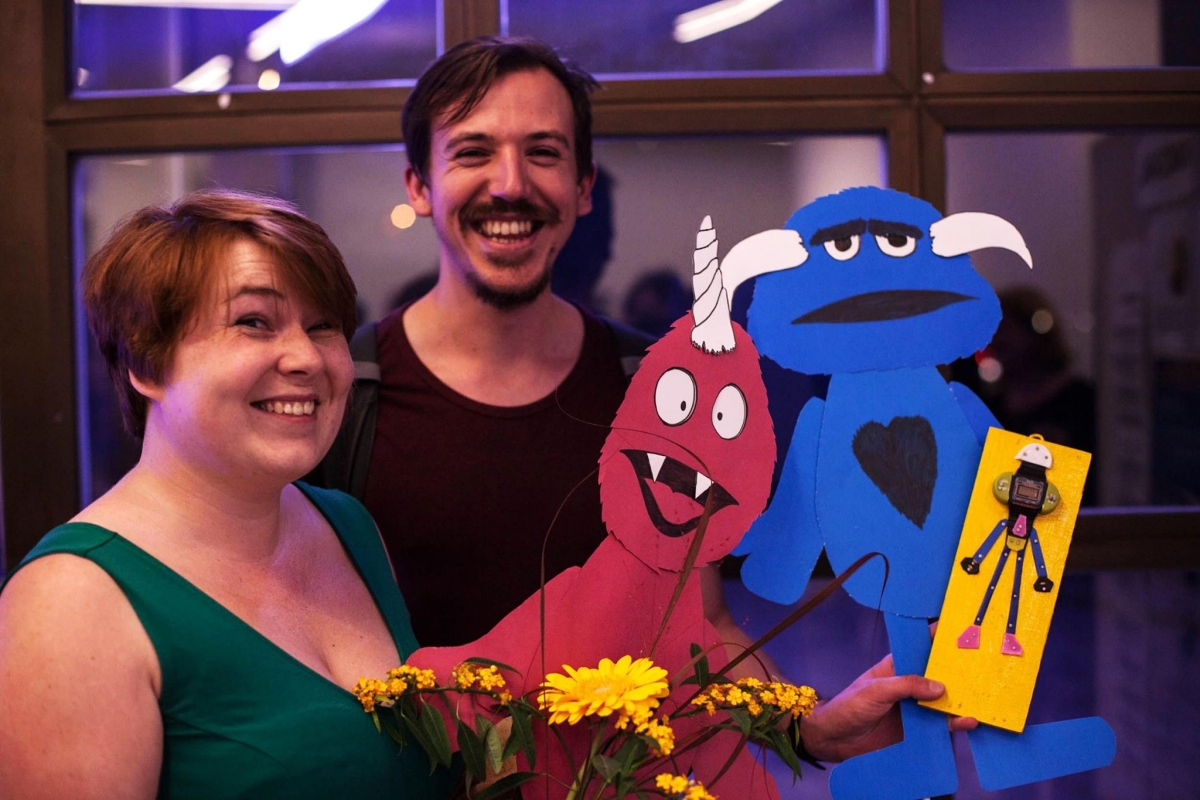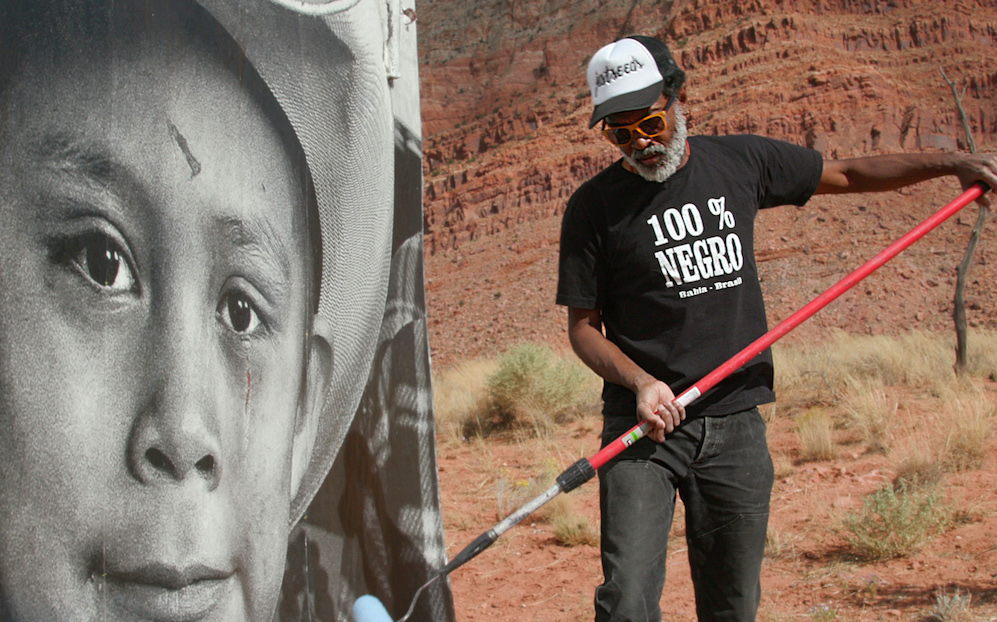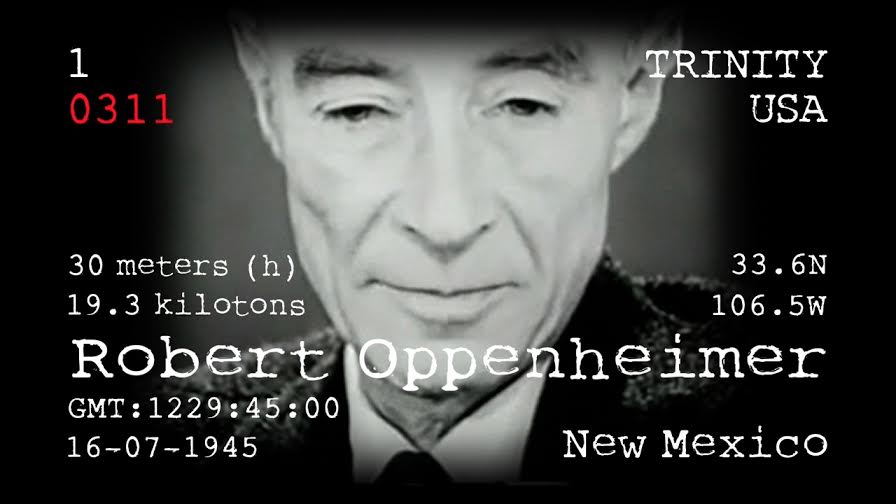2023
The Best 1st Feature Documentary Award to
Inter-Continental Bunker Mission - I.C.B.M.
It’s May, 2018. Nils is arriving back to his home in the suburbs of Stockholm, Sweden. As he opens the door, a leaflet is caught in the letterbox entitled: “If War or Crisis Comes”. It is a leaflet distributed to every household in Sweden, sent out by the government for the first time since 1962 – when the world was in the midst of the Cuban Missile Crisis. Together with his best friend Julian, Nils embarks on an Inter-Continental Bunker Mission; to learn from the best in order to outlast what calamity is sure to come. Nils and Julian go on a journey around the world to find out what a global nuclear war, and the end of the world might look like, and how they might try to prepare for such a scenario. Finally, after months of traveling to gather opinions and knowledge on the subject, they construct and live in a fallout shelter – in Nils’ parent’s basement in Stockholm. From pretending the world has ended at a Post-Apocalyptic Festival in Poland, to encounters with hardcore survivalists in the United States, to meeting with survivors of the Hiroshima Atomic bomb attack in Japan, Nils and Julian hope their journey inspires others to join the debate on what we can do as a global community to prevent such disasters from happening. ICBM is an accessible and entertaining documentary, with the potential of creating debate and further outreach on the subject of nuclear arms, collaborating with organisations such as The Bulletin of the Atomic Scientists, Hiroshima Interpreters for Peace and others. The film aims to be funny, turned serious, and encourage younger generations to engage with those generations who lived through the cold war on a subject that in today’s darkening political climate is becoming ever more concerning.
Inter-Continental Bunker Mission is a documentary with a sense of humour on fallout shelters, government survival plans and self-made basement bunkers to survive a nuclear apocalypse. „Julian Vogel has put together a brilliant film that is as playful as it is timely. The form and the content of this wonderful film are in harmony with its subject matter and message“, said festival judge, filmmaker and film scholar Miguel Silveira. „The film was produced with financial support from the Scholarship Foundation for the Studies of Japanese Society”. www.vogelperspektiv.se / www.jackallenfilm.com/icbm/ / Trailer: https://vimeo.com/537390683The Best Investigative Documentary Award to
Radioactive: The Women of Three Mile Island
The Best Documentary Feature Award to
Downwind
Miguel Silveira: „Downwind has Hollywood star power, slick production value, as well as the historical and scientific accuracy required for any film to be the big winner of the Uranium Film Festival 2023“, said festival judge, filmmaker and film scholar Miguel Silveira. „Downwind is a solid piece, the one with the largest reach and the potential for communicating the issues we all fight against to the largest number of people. It's a very important film that helps bring back the debate about nuclear energy - and war - to the mainstream.“ This documentary on "Downwinders" affected by the hundreds of atomic bomb test explosions in Nevada and nuclear-technology related topics features stars and activists like Martin Sheen, Claudia Peterson, Ian Zabarte, Patrick Wayne, Mary Dickson, Lewis Black, Joseph Musso and Michael Douglas. Mark Shapiro & Douglas Brian Miller Award Acceptance Speech!
The Best Documentary Short Film Award to
Small and Big
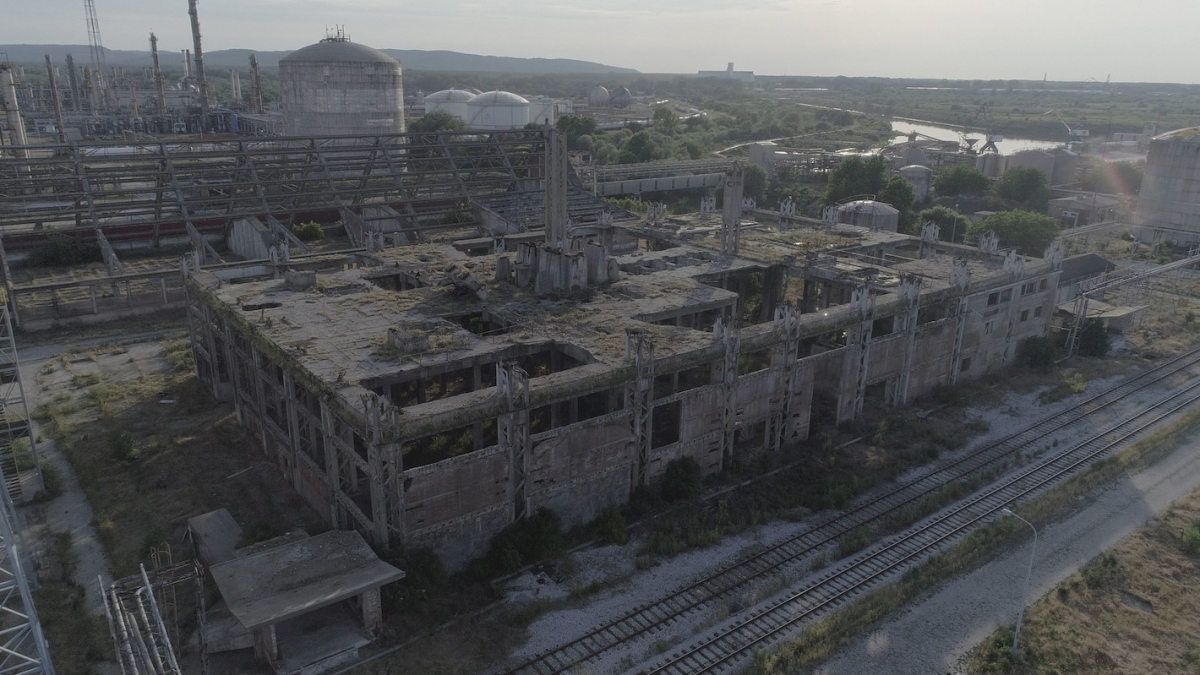
Depleted Uranium activist and scholar Damacio A. Lopez from New Mexico received the Award in the name of the director. „This documentary show us the consequences of the wide spread use of depleted uranium ammunition by the NATO in Serbia und the victims as we have not seen it before. Very moving, very authentic“, said Damacio Lopez.
Honorable Mentions to
Sew to Say
A Body in Fukushima
How Far From Ground Zero
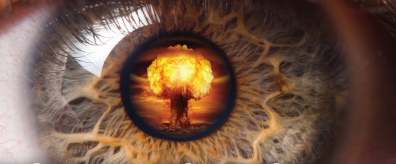
Chernobyl: The Lost Tapes
Tortoise Under The Earth (Dharti Latar Re Horo)
Neutron Bomb
2022
Best Fiction Short Film Award
JANUARY 66 (ENERO DEL 66)
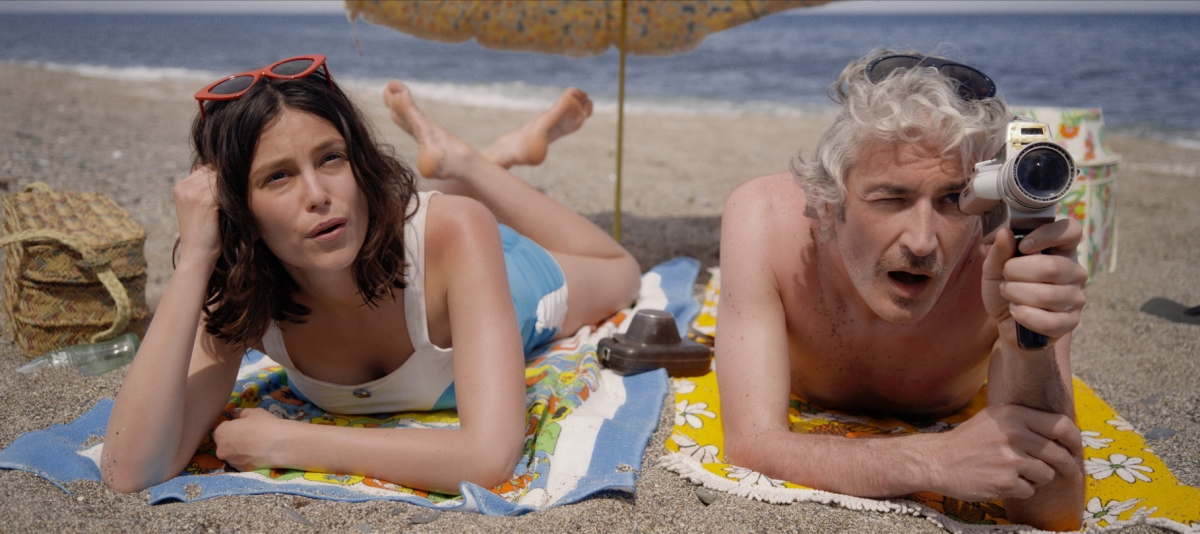
Spain, 2022, Director & Producer: Jaime García Parra, Fiction/Comedy, Spanish with English or Portuguese subtitles, 14 min.
January 1966 in the south of Spain, a tourism couple is recording themselves in a placid day at the beach. Behind them, some locals decide to cheat on a shepherd, who will play his honor
before the eyes of his beloved in a curious game. Tourists are attracted to the strange game and decide to record it, without being aware of the hecatomb that will happen before the camera.„January 66“ is based on the real atomic bomb accident of Palomares during the Cold War: On 17 January 1966, a B-52G bomber of the USAF Strategic Air Command with four atomic bombs collided with a KC-135 plane tanker during mid-air refueling over the Mediterranean Sea, off the coast of Spain at Palomares. Of the four hydrogen bombs the B-52G carried, three felt on land near the small fishing village Palomares in Almería resulting in the contamination of an at least 2-square-kilometer area by plutonium. The fourth atomic H-bomb fell into the Mediterranean Sea and was lost.
Trailer: https://selectedfilms.com/enero-del-66
The Best Documentary Feature Awards
OUR FRIEND THE ATOM: THE AGE OF RADIOACTIVITY
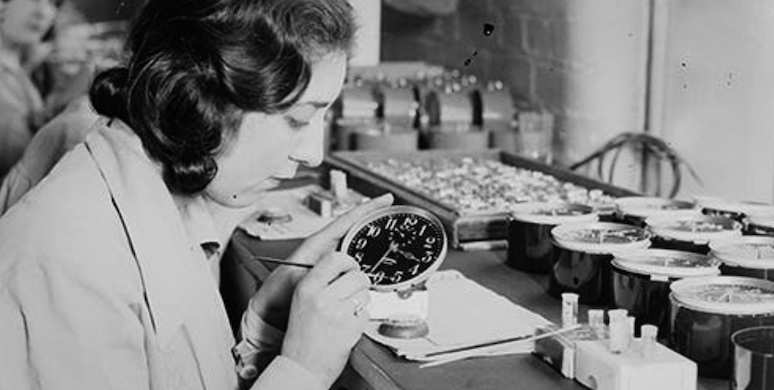
(Notre ami l'atome : Un siècle de radioactivité)
France, 2020, Directed by KenichiWatanabe, Production: Kami productions,
Documetary, English/French, 56 min.
The USS Ronald Reagan cruised into a radioactive cloud from the Fukushima nuclear power plant in March 2011. Sailors on the aircraft carrier were exposed to radiation. This documentary looks at the event and what came before it. The film is a historical investigation into the phenomenon of radioactivity. From the Curie spouses to Fukushima, through the history of atomic bombings and nuclear disasters, the film gives meaning to the stories of victims, soldiers and irradiated children, while revealing the lies of the world of the atom. Info/Trailer: www.kamiproductions.fr
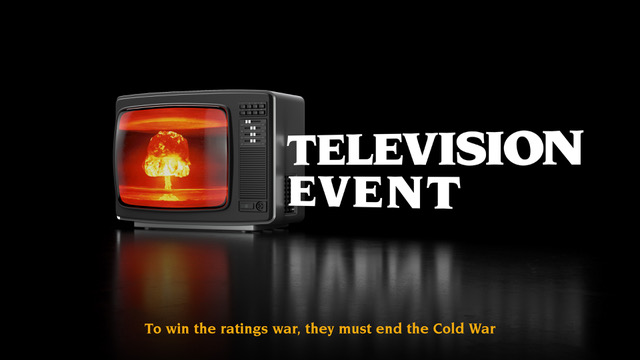
USA, 2020, Director & Producer: Jeff Daniels, Documentary, English, 91 min.
THE KID STAYS IN THE PICTURE meets THE ATOMIC CAFE in this archive-based feature documentary that views the dramatic climax of the Cold War through the lens of a commercial television network, as it narrowly succeeds in producing America’s most watched, most controversial made-for-TV-movie, THE DAY AFTER , in 1983. This film addresses a universal challenge - grasping how vast global issues such as climate change, the refugee crisis and in this case nuclear proliferation affect us personally. We have much to learn from how this television network took a subject so terrifying, so unpalatable and turned it into prime-time family viewing. With irreverent humor and sobering apocalyptic vision, this film reveals how a commercial broadcaster seized a moment of unprecedented television viewership, made an emotional connection with an audience of over 100 million and forced an urgent conversation with the US President on his policy towards nuclear proliferation. Film website: www.televisionevent.com / Trailer
Best Documentary Short Awards
TOXIC NEIGHBOUR
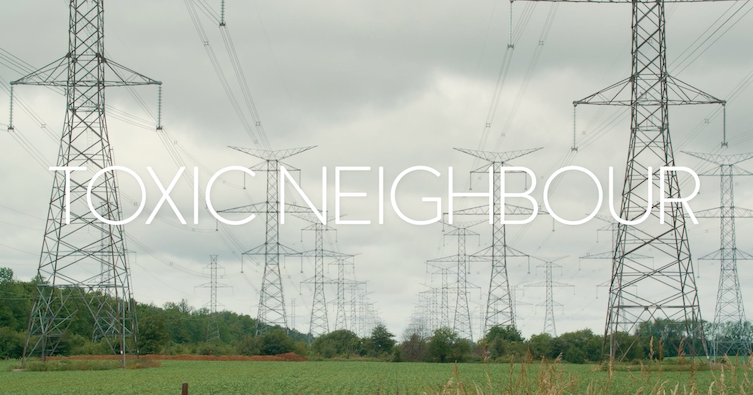
Canada, 2021, Director: Colin Scheyen, Producer: Ann Shin and Hannah Donegan,
Documentary, English with Portuguese subtitles, 25 min.
Eugene Bourgeois had no concerns about nuclear energy when he built his farm next door to the world's largest nuclear facility in 1974. Over that time, he and his wife Ann ran a successful wool business and taught generations of people around the world the art of knitting. They really believed they had found paradise. However, over the next few decades, Eugene, his family, and his sheep flock were frequently exposed to hydrogen sulfide, a deadly nerve gas from the nuclear plant, which caused hundreds of his sheep to be blinded, born deformed, or killed. The industry has denied any wrong doing, but Eugene has always known the truth and dedicated the rest of his life to pushing his nuclear neighbour for greater transparency and accountability. Trailer: https://vimeo.com/609829443
"Congratulations on an amazing festival this year! I followed it as much as I could on Social media and wished I could have been there. It truly is an incredible honour to receive such an amazing Award from your festival. Your festival does an amazing job of bringing ideas, conversations, people, and films together. Thank you! I hope my film inspired people to keep fighting the industry and always put love behind your activism." Colin Scheyen
SEA GYPSIES: THE PLUTONIUM DOME
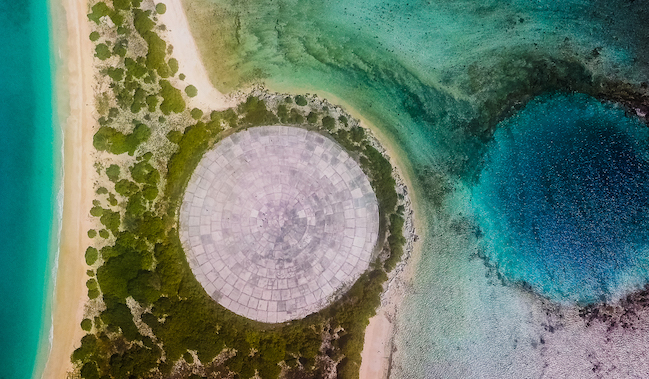
2021, USA/Marshall Islands, Director Nico Edwards, English with Portuguese subtitles, 35 min.
I︎︎︎︎︎︎︎n the middle of the pacific ocean, the sailing ship Infinity and her ragtag crew stumble upon one of the most dangerous islands on earth. Birthplace of the hydrogen bomb, this tiny atoll absorbed the nuclearequivalent of 1.5 Hiroshima bombs a day for 12 years. That legacy waits near the beach, in a giant unguarded crumbling concrete dome. Atomic Test Clean-up Veteran Paul Griego about the film: „I feel it is as great film and so have the other atomic cleanup personnel I have spoken to.“
Trailer: https:// www.seagypsies.com/the-plutonium-dome
Best Fiction Feature Film Award
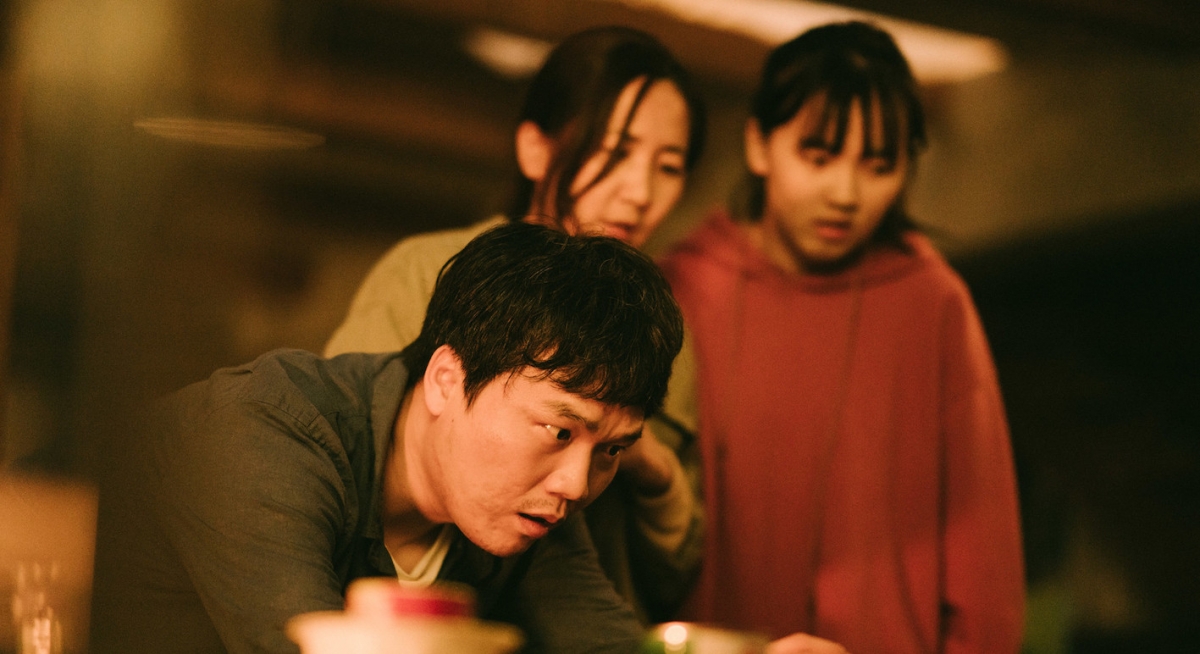
South Korea Year, 2020, Director: Choi Yang Hyun, Producer: Lee Jieun, Fiction,
Korean with English or with Portuguese subtitles, 94 min.
Pan-Gyo which is Korean Silicon Valley was attacked by Nuclear bomb. The member of family who is owned venture business decided to hide at basement in their house for 2 weeks in accordance with direction from Korean Government. The family was started to struggle to survive in the basement day by day... The film was produced during Covid-19 Pandemic in 2020. This film invokes metaphor for a middle class life when they tried to survive against a risk of extinction such as nuclear attack or pandemic while they were isolated drastically from the outside. Choi Yang Hyun was born in Seoul. He received his BA film directing and Korean literature at university and his MA image engineering at graduate school. His short feature films have been nominated or won in many film festivals. Currently, He is directly managing a film production called Paranoi Future Cinema Lab. "The Basement" is his first full length feature film.
Best Feature Fiction Movie
VALLEY OF THE GODS (Dolina Bogów)
by brilliant Polish multi-artist Lech Majewski.
Poland/Italy/Luxemburg/USA, 2019, Director Lech Majewski, Producer Lech Majewski and Filip Rymsza, Co-production Poland-Luxembourg, Royal Road Entertainment, Cast: Josh Hartnett, John Malkovich, John Rhys-Davies, Bérénice Marlohe, Keir Dullea, Steven Skyler, Joseph Runningfox, Ficition, 126 min, English with Portuguese subtitles.
The film weaves together three narrative threads: Navajo archaic legend about gods locked inside the rocks of the Valley of the Gods; a story of the wealthiest person on earth, Wes Tauros (John Malkovich), who lives hidden away from the world suffering from a personal tragedy; and that of the narrator, John Ecas (Josh Hartnett), who works as a copywriter at Tauros’s company. After a traumatic split from his wife, John starts writing his boss’s biography and accepts an invitation to his mansion. At this time Tauros’s company, which mines uranium ore, buys the Valley of the Gods to bore tunnels through the sacred land. The shattered peace of Navajo ancestors makes the rocks give birth to an avenger.
Lech Majewski's film, that was already awarded as Best Feature Fiction Movie at the Uranium Film Festival in Berlin in 2020 now received the festival trophy of the Uranium Film Festival in Rio.
The film screening was also honored by the presence of Poland's ambassador to Brazil, Jakub Skiba, who said: "I would like to express my exceptional satisfaction with the fact that the respected and outstanding Polish director Lech Majewski was awarded at this important event in the Brazilian cinema world. Majewski's works are both visually and philosophically sophisticated. His films, including Valley of the Gods, are dreamlike in nature, referring to the greatest existential fears of each of us. Thanks to their creativity, the viewer can experience a profound act of purification and catharsis. Few films manage to have the same sense of symbolic and archetypal weight".
Honorable Mentions
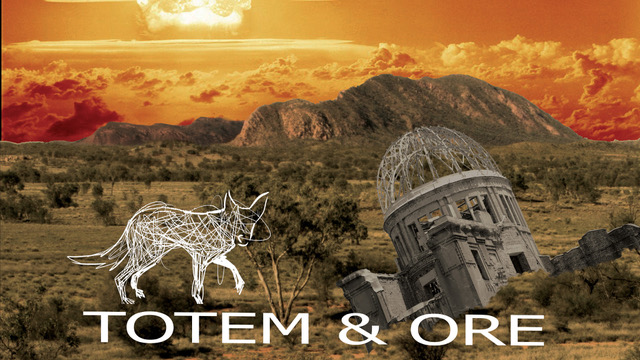
by John Mandelberg (Australia)
Australia, 2019, Director & Producer: John Mandelberg, Executive Producer: Bozic Wongar,
Actress and Narrator: Ursula Yovich, Documentary, English, Japanese, Russian, English & Portuguese subtitles, 97 min.
TOTEM & ORE starts in 1945 with the Hiroshima bombing and ends with the Fukushima nuclear meltdown in 2011. The film explores the effects of Nuclear bombs and weapons testing across the globe, from the Manhattan Project's first Atomic bomb test in the desert of Nevada, to the Hiroshima and Nagasaki bombs in 1945, and the first British thermonuclear test at Christmas Island in the Gilbert Island chain in the North Pacific in 1963. In Australia, the tragedy of uranium exploration, mining and British atomic testing in 1950’s Aboriginal Australia. Starting at the Hiroshima bomb and ending at the nuclear meltdown in Fukushima. The historic tragedies and fear told by atomic bomb witnesses, activists, filmmakers, artists, actors, writers composers, doctors, professors. Aboriginal Actress, Ursula Yovich reflects on her visit to Hiroshima, her appeal that “No place in the world for Nuclear weapons!”
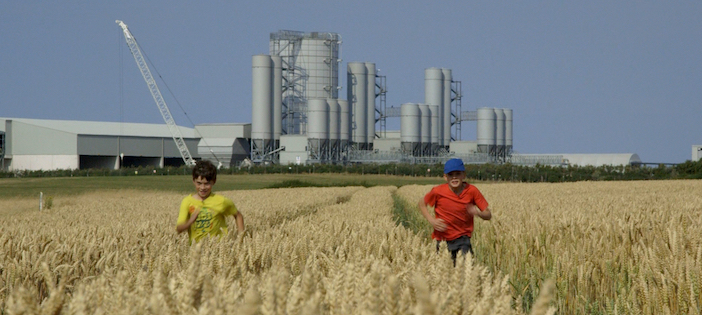
by Ömer Sami (Denmark/UK)
Denmark/UK - 2019, Director Ömer Sami, Documentary, English with Portuguese subtitles. 23 min.
Growing up in the shadows of Britain’s biggest new nuclear power plant, Hinkley Point C, eleven-year-old Sam is worried about what it means for the world around him and must decide what kind of person he wants to be. Drifting between his daily life and dreams, the film explores themes of holding on and letting go, and growing up. Sam believes the only way is to go a private school – but his parents can’t afford the offer. As a last resort, they turn to the power company for funding, forcing Sam to decide. This Guardian documentary meets a boy who must choose between opposing Hinkley Point C nuclear power plant and benefiting from its educational bursary. Hinkley Point, on the Somerset coast, is the biggest building site in Europe and the most expensive nuclear power station in the world.
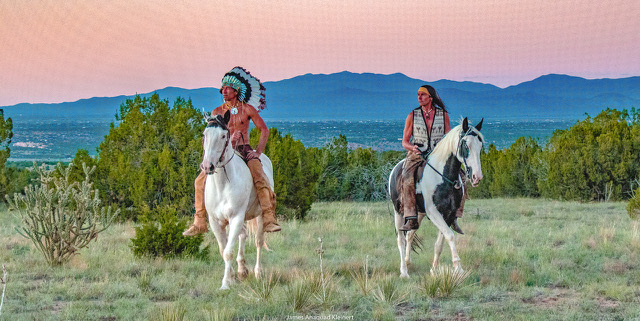
by James Anaquad Kleinert (USA)
USA, 2020, Director & Producer James Anaquad Kleinert, Documentary, English, 127 min.
Stunning Cinematography highlighting Majestic South Western Landscapes & Ecosystems, featuring Viggo Mortensen, Sheryl Crow, Willie Nelson and others, this is a film that audiences will resonate deeply with, as our Plight to Protect the Wild Horses mirrors our fight for a Sustainable Future: "Mustangs & Renegades" is a complex web of events woven into the heart of the American west, documented over a 18 year period. It Follows the true & personal account of Film Maker James Anaquad Kleinert as he document’s the Round Up & Removal of America’s Wild Horses. In Revealing the plight of our Wild Horses, James shows how Public Lands in the US are being sold off to the highest bidders exposing the Privatization of US Publics lands by the Brutal Multi National Extractive Industries.
"Mustang & Renegades" is an epic and honest tale of Activism, Passion, Perseverance and Transformation that touches the core issues - The Protection of our Natural Environment, Constitutional, Civil and Indigenous Rights that are massively threatened! The film is based on the Book: No Country For Truth Tellers by James Anaquad Kleinert.
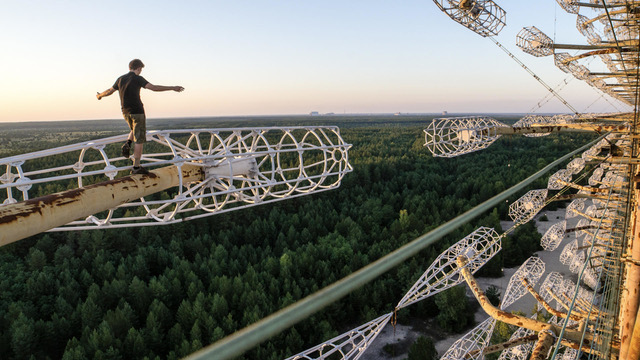
by Iara Lee (Ukraine/USA/Bulgaria/Slovakia).
Ukraine/USA/Bulgaria/Slovakia, 2020, Director & Producer: Iara Lee, English/Russian /Ukrainian, Subtitles English or Portuguese, 57 min.
Stalking Chernobyl, a forthcoming documentary from Cultures of Resistance Films, examines the underground culture of the Chernobyl Exclusion Zone. Three decades after the world's most infamous nuclear disaster, wildlife has returned in the absence of human settlements. Meanwhile, illegal hiking adventurers known as "stalkers," extreme sports aficionados, artists, and tour companies have begun to explore anew the ghostly, post-apocalyptic landscape. Info/trailer: https://culturesofresistancefilms.com
2021
BEST ARCHIVAL DOCUMENTARY AWARD to
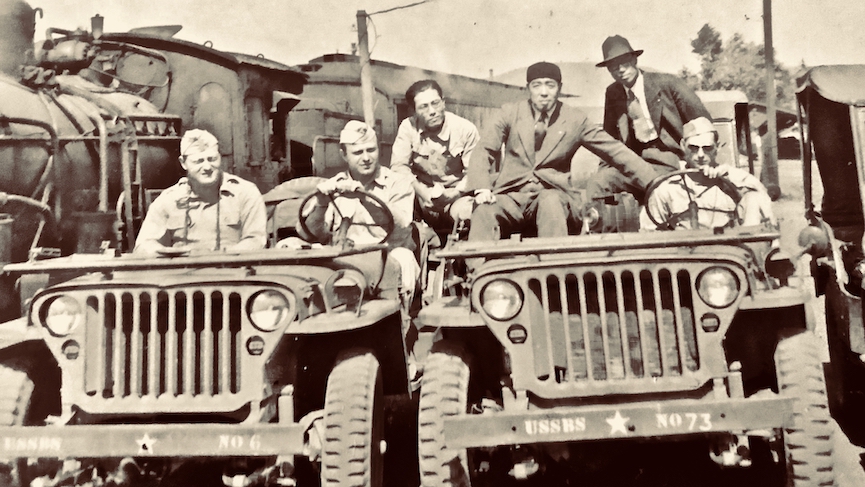
BEST FEATURE DOCUMENTARY AWARDS TO
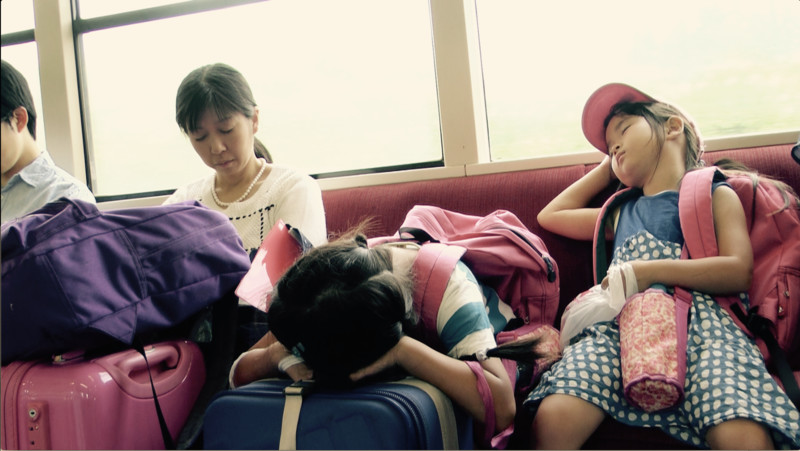
There are many evacuees who had been driven into the poverty after the Japanese government cut off the housing subsidies for those who fled their house after the nuclear disaster in Fukushima in March 2011. Kazuko, who fled her house to Tokyo with her two primary school daughters, has to work over the weekend to pay the expensive rent in Tokyo. She is irregularly employed, which means that if she gets sick, it would affect her income. There are still 70,000 evacuees from contaminated area and this is the documentary to address once again, what is the actual revitalization. TRAILER
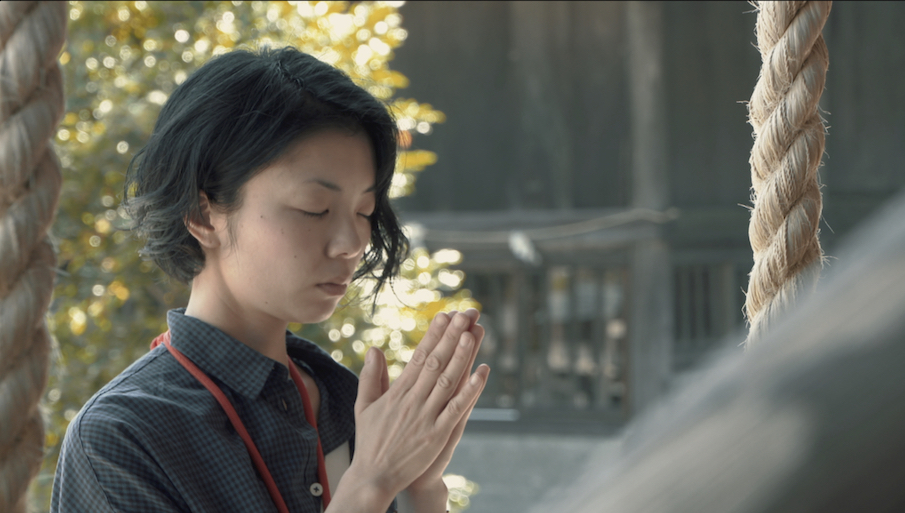
France, 2021, Director Keiko Courdy, Producer PIKA PIKA FILMS, Music by Ryuichi Sakamoto and Seigen Ono,
Support from KissKissBankers, Documentary, 87 min, Japanese with English / Portuguese subtitles.
Waves crash eternally on the shore of Fukushima Daiichi Nuclear Power Plant. Next to a white facility for radioactive waste burning, black bags of contaminated soil pile up while a family looks for traces of their house. The film relates the stories of people who survived the tsunami and were forced to leave their home, people who came back in the darkest times, and people who came to work from far away, decontamination workers of Fukushima Daiichi. In the zone, invisible traumas are everywhere. There is no life without risk but what risk are we ready to take? In Japan, everyone wishes to forget and go forward, but the traces can not be erased that easily. TRAILER
HONORABLE MENTIONS
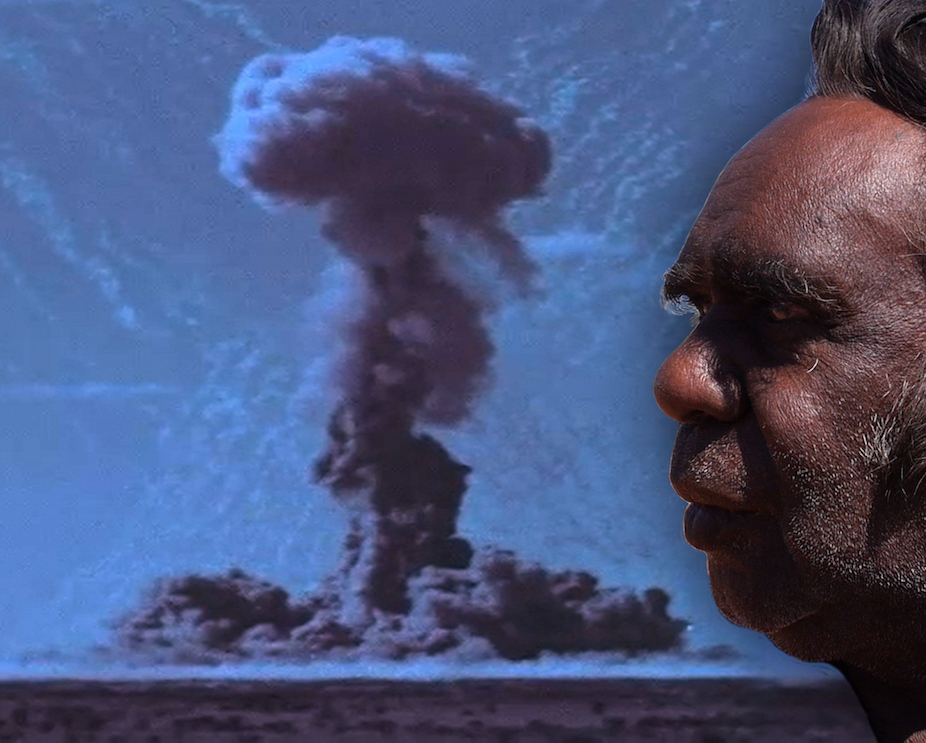
2020
Best Feature Movie
The Uranium Film Festival jury gave the Best Feature Movie Award to the drama movie VALLEY OF THE GODS (Dolina Bogów), written and directed by Lech Majewski, starring Josh Hartnett, John Malkovich, Bérénice Marlohe, John Rhys-Davies, Jaime Ray Newman and Laura Ecas.
Jury Statement
„The International Uranium Film Festival had always deep respect for indigenous peoples and especially for the Navajo Nation“, said German actor and producer Timo Jacobs in the name of the festival’s jury. „For that the Uranium Film Festival has already taken place twice in Window Rock, the capital of the Navajo.“
Timo Jacobs: „Since the 1940s, the Navajo, who call themselves Diné, have suffered from uranium mining and its radioactive legacy. More than 500 abandoned uranium mines and unsecured tailings contaminate soil, air and water of the Navajo Nations with radioactive and toxic elements. Any film that deals with this tragedy, which is largely ignored by the public, deserves the attention of the Uranium Film Festival. This is especially true for the feature movie Valley of the Gods. Lech Majewski shot his film with the greatest respect for the Navajo Nation and tried to convey the topic from their point of view. Even more: Director Lech Majewski managed to win over well-known film stars such as John Malkovich and Josh Hartnett for his film, which makes it all the more valuable. Valley of the Gods can therefore bring the question of uranium mining and its disastrous consequences for the Navajo to Hollywood. This brings the topic closer to a world that has so far been almost impossible to reach through documentary films. For this reason alone, Lech Majewski deserves an award from the Uranium Film Festival.“
„Personally, I allow myself the opportunity to grab my head and thank you very much for this film. To be able to present you this award is worth more to me than to present Stephen Spielberg with an Oscar. Your magical realism is a gift for every movie lover. Keep motivated and communicate with us through art.“
Best Feature Documentary
BALENTES - THE BRAVE ONES (I CORAGGIOSI)
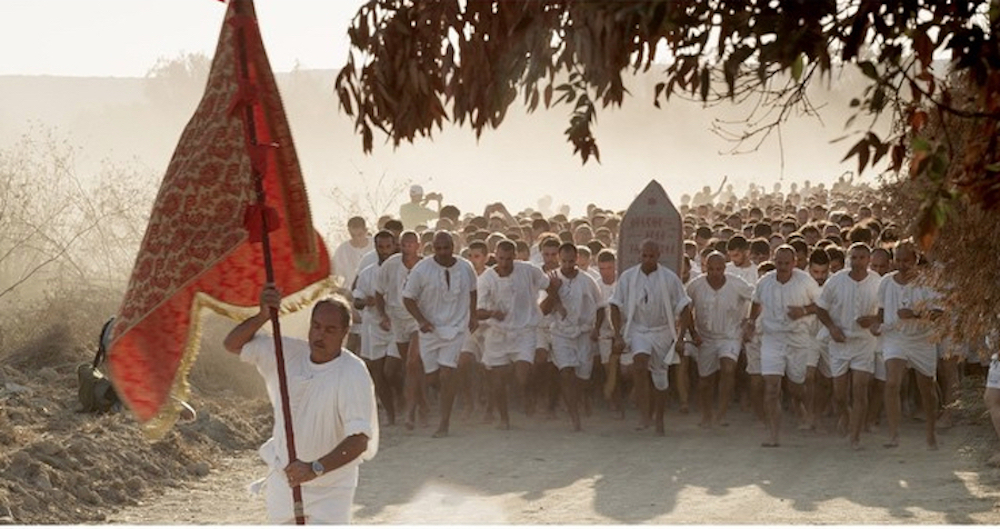
Jury Statement
„The film deals with a central, highly topical question of the international peace and environmental movement: environmental destruction through war and other military activities. This is done using the example of Sardinia, where this can be seen particularly clearly,“ justified Prof. Manfred Mohr for the Uranium Film Festival.
Manfred Mohr: „The documentation impressively contrasts the wonderful landscape of the island with the terrible devastation on the military training areas and in their surroundings. One of the problems behind this, but not the only one, is the use of uranium or DU weapons. For years ICBUW is campaigning for a global ban of these weapons."
„The film impresses with its high level of professionalism, coupled with a great personal and political commitment in favour of the people affected and the tortured nature. BALENTES - THE BRAVE ONES does not stop at the description of the problem and the condition, but broadly and convincingly illustrates the revolt of the Sardinian population against it. A masterpiece worthy of an Uranium Film Festival Award in every aspect.“
Honorable Mentions
Germany, 2020, Director Claus Biegert, Production Biegertfilm, Music by Zoro Babel,
Documentary, 103 min, German / English
Hans-Peter Dürr, as a physicist he followed the footsteps of the world re-nowned Werner Heisenberg. As a peace activist he was torn between his PhD supervisor Edward Teller and peace Nobel laureate Josef Rotblat, both of them involved in the Manhattan project during World War II. When it became obvious that Hitler would not built an atomic bomb (Wunderwaffe), Rotblat immediately resigned from Los Alamos, Teller stayed and became the "father of the hydrogen bomb". In the early 1950s, the young and naive Hans-Peter from Stuttgart, Germany, stepped into the bomb euphoria in Berkeley, California. It shaped his life.
He became a role model for a scientist with responsibility
2019
BEST BRAZILIAN SHORT DOCUMENTARY
Cidade Radioativa (Radioactive City)
Brasil, 2017, Director Marcello Marques, Producer Elisângela Guanaíra, 26 min, Portuguese. The town of Caetité is 650 kilometers from Salvador (BA). It is home to one of the largest reserves of uranium in Brazil, a mineral that feeds the Angra 1 and Angra 2 nuclear plants and is considered highly hazardous when concentrated. “The Environmentalist” went to the place to listen to the population, who is alarmed about the efficiency of monitoring the water quality in the region, considered contaminated. This suspicion has already led to the closure of several artesian wells. Trailer: http://oambientalista.com.br/cidad-radioativa/
"Uranium Film Festival judge Alphonse Kelecom, a professor of radiobiology at the Fluminense Federal University, said: “Radioactive City is an interesting film about the uranium mining town Caetité that can serve as a beautiful discussion on the aspects of environmental contamination caused by uranium mining.”
SPECIAL RECOGNITION
THE SISTERS OF NAGASAKI (Les sœurs de Nagasaki)
„With unique archive footage Alain Vézina skillfully tells of an extraordinary story about atomic bomb victims and survivers (Hibakusha) that has not yet been told“, writes the festival’s jury. „We screened the film last May during our 9th International Uranium Film Festival in the cinema of Rio de Janeiro’s famous Modern Art Museum, and the selected audience was very impressed by the movie“, added festival director Norbert G. Suchanek.
2018
BEST SHORT DOCUMENTARY
ANOINTED
Marshall Islands, 2018, Directors Dan Lin & Kathy Jetnil-Kijiner, poem video, English, 6 min - A powerful poem video about the legacy of the US atomic bomb tests on the Marshall Islands and the Runit dome nuclear waste site in the Enewetak Atoll. https://www.kathyjetnilkijiner.com
"Photographer and filmmaker Dan Lin and poet Kathy Jetnil-Kijiner are masters at uniting nature, poetry and atomic bomb tests. As eloquent as the poem, so poignant is the cinematic footage by Dan Lin“, says Thomas Zandegiacomo Del Bel, film curator and media scholar for the Uranium Film Festival. Representing Kathy Jetnil-Kijiner, the 16-year-old Berlin Philippo from the Marshall Islands received the award in Berlin.
BEST ANIMATION
Freddy and Fuzmo Fix The World
UK, 2018, Directors & Producers: Christopher Murray, Luke Biddiscombe & Mikel Iriarte, further Producers Matt Rose, Laura Johnson, Muppet Animation, 27 minutes, English - Nineteen months after being sent to earth to fix the world’s problems, Fuzmo, an omnipotent alien-being jaded by the corporate machine, has lost all motivation and now lives in a gluttonous and lethargic lifestyle, leeching off his good-natured flatmate Freddy. In an effort to be productive, twenty-something Freddy tries to persuade Fuzmo into creating world peace. The intervention of new house guest Grumble divides the trio, who find themselves locked in a nuclear arms race, with the fate of Big City hanging in the balance. https://www.facebook.com/freddyandfuzmo/ - Trailer: https://www.youtube.com/watch?v=RtItRNAH8Aw
"Freddy and Fuzmo Fix the World is simply a well-made, laughter-stimulating Muppet show on nuclear war. Documentary films about nuclear power and it's consequences are sometimes depressing. For that it is just as important to have atomic films that make us laugh. And that's what Mikel Iriarte and Laura Johnson and their film team did masterfully“, said festival director Norbert G. Suchanek.
Best Archival Footage Documentary
ONE HUNDRED YEARS OF URGEIRIÇA - CEM ANOS DE URGEIRIÇA
UK/Portugal, 2016, Director Ramsay Cameron, Producer Molitor Productions, documentary, English/Portuguese, German subtitles 52 min - The film tells the story of the 100 year history of the Minas da Urgeiriça in Northern Portugal. The mine was one of the earliest uranium mines and was linked directly to Marie Curie, during the Second World War the British and American governments recognized its strategic importance and invested heavily in it to provide nuclear fuel for the Cold War. Later the mine was returned to Portuguese ownership and the dictator Salazar dreamt of creating a Portuguese nuclear industry, eventually it was the source of the uranium that Saddam Hussein procured for his attempt to build a nuclear reactor. https://vimeo.com/170159651
"Skillfully, Ramsay Cameron uses unique archive footage and eyewitness interviews to reveal the important involvement of Urgeiriça in the Manhattan program. It is an excellent film to open our eyes on the history of this uranium mine in north-central Portugal and on its participation in the construction of the first US and UK atomic bombs", says Márcia Gomes de Oliveira, co-founder and director of the Uranium Film Festival.
Best Art Documentation 2018 - Jury Award
Dignity at a Monumental Scale
USA, 2018, Director & Producer Kelly Whalen, Art-documentary, English, 8 min - When images of everyday Navajo life began appearing at a monumental scale on abandoned buildings, roadside stands and water towers across the Four Corners region, it was a surprise for many in the community to discover it was the work of Chip Thomas (aka Jetsonorama), a long-time resident known by many as a healer of another kind. https://vimeo.com/261408010
"I understand this movie as a declaration of love to the Navajo people.The film is also a call against forgetting and gives hope for a fairer future" says Timo Jacobs (actor, director and producer who lives and works in Berlin) for the Uranium Film Festival. (Award will be given in Window Rock)
Best Feature Documentary 2018 - Berlin Audience Award
Atomic Homefront
USA, 2017, Director & Producer: Rebecca Cammisa, Producer James B. Freydberg & Larissa Bills, 96 min, Documentary, English, 96 min - The City of St. Louis has a little known nuclear past as a uranium-processing center for the Atomic bomb. Government and corporate negligence led to the dumping of Manhattan Project uranium, thorium, and radium, thus contaminating North St. Louis suburbs, specifically in two communities: those nestled along Coldwater Creek – and in Bridgeton, Missouri adjacent to the West Lake-Bridgeton landfill. Another tragic and bizarre occurrence has been unfolding in Bridgeton, Missouri. In 1973, approximately 47,000 tons of the same legacy radioactive waste was moved from Latty Avenue and was illegally dumped into a neighborhood landfill named West Lake. This landfill became an EPA Superfund site in 1990. For the last seven years, an uncontrolled, subsurface fire has been moving towards an area where the radioactive waste was buried. Atomic Homefront is a case study of how citizens are confronting state and federal agencies for the truth about the extent of the contamination and are fighting to keep their families safe. Trailer https://www.atomichomefront.film
"The audience in Berlin, including filmmakers and nuclear experts and physicians were overwhelmed by Atomic Homefront and by the brave mothers from Saint Louis who created Just Moms STL", says festival director Norbert G. Suchanek. (Award will be given in Window Rock)
Young Talent Documentary Film Award
URANIUM DERBY
US, 2017, Director Brittany Prater, documentary, English, 83 min - A young woman’s investigation into her hometown’s secret involvement in the Manhattan Project triggers a chain reaction of encounters through which it becomes clear that the topic of nuclear waste has been more successfully buried than the waste itself. Uranium Derby portrays the manner in which Superfund site cleanup is often mishandled in the U.S., and informs the viewer about how toxic waste can spread, and why waste-site cleanup is often prolonged or avoided altogether. Because private companies contracted to clean up waste sites tend to hold considerable political leverage, they are able to devise strategies that greatly extend cleanup schedules, thus ensuring the longest possible inflow of government funds. „A filmmaker discovers her hometown was secretly involved in the Manhattan Project. Her investigation into this history triggers a chain reaction of encounters through which it becomes clear that the topic of nuclear waste has been more successfully buried than the waste itself.“ http://uraniumderby.com/
"The audience enjoyed Uranium Derby. It is a well done film, well researched and raised a lot of information to view that wasn’t previously in the public knowledge", Uranium Film Festival Jury
Young Indigenous Filmmaker Award
Doodá Leetso - The Legacy of Navajo Nation Uranium Mining
USA, 2015, Director Deidra Peaches, Directed/Edited: Paper Rocket Productions, Producers: Tolani Lake Enterprise, Funders: Indigenous Environmental Network, Western Mining Action Network, Colorado Plateau Foundation, Christensen Fund, Special Thanks: Chris Shuey, Johnney Lewis, Tommy Rock, Edith Hood, Larry King, Bertha Nez, Rolanda Tohannie, Music by BC Campbell, 15 min - The abundance of toxic exposure due to abandoned Uranium mines; left by defunct corporations, continue to endanger the Diné People.
SPECIAL RECOGNITIONS
Too Precious to Mine
USA, 2017, Director Justin Clifton, Documentary, English, 10 min, German subtitles - The Havasupai Tribe depends on the blue-green waters that emerge in the Grand Canyon for drinking water. But now, uranium mining on the canyon’s rims threatens the tribe’s existence and its way of life. A 20-year ban on new uranium mining claims around the Grand Canyon is at risk of being overturned by the Trump administration. The Grand Canyon is an irreplaceable natural treasure that draws over 5.5 million visitors to the park each year. Yet, irresponsibly operated uranium mines located on federal public land just miles from the North and South Rims threaten to permanently pollute the Grand Canyon landscape and the greater Colorado River. Film: https://vimeo.com/241576331 - https://www.grandcanyontrust.org/too-precious-mine
„Justin's short film makes it clear: The Grand Canyon is the last place on Earth we should mine uranium - not today, not in 20 years, never", Uranium Film Festival Jury
The Safe Side of the Fence
USA. 2015, Director Tony West, Documentary, English,108 min - "World War II's Manhattan Project required the refinement of massive amounts of uranium, and St. Louis-based Mallinckrodt Chemical Works took on the job. As a result, the chemical company's employees would become some of the most contaminated nuclear workers in history. This documentary explores the legacy that St. Louis is still coping with, from workers who became ill - to the challenges of dealing with the fallout of creating some of the world's first nuclear waste.The story is not unique to St. Louis, as more than 300 facilities across America would become part of the race to build the bomb, and be forced to deal with many of the same issues. A detailed look into what some of the men and women went through inside these plants, and how decisions made in the past affect us all today. http://www.thesafesideofthefence.com
KUANNERSUIT / KVANEFJELD
UK/Denmark, 2017, Directors Joshua Portway and Lise Autogena, Producer Lise Autogena, Documentary, Danish and Greenlandic with English subtitles, 30 min
The film is a work in-progress, forming the first part of the artists’ long-term investigation into the conflicts facing the small, mostly indigenous, community of Narsaq in southern Greenland. Narsaq is located next to the pristine Kvanefjeld mountain; site of one of the richest rare earth mineral resources deposits in the world, and one of the largest sources of uranium. Greenland is a former colony of Denmark, which is now recognised as an “autonomous administrative division” of Denmark, supported economically by the Danish state. Many people see exploitation of mineral deposits as the only viable route to full independence. For generations the farming near Kvanefjeld has been Greenland’s only agricultural industry. This way of life may soon be threatened, as Greenland considers an open pit mine proposed by Greenland Minerals and Energy, an Australian company. The mine would be the fifth-largest uranium mine and second-biggest rare earth extraction operation in the world. Autogena and Portway’s film portrays a community divided on the issue of uranium mining. It explores the difficult decisions and trade-offs faced by a culture seeking to escape a colonial past and define its own identity in a globalised world. Trailer: https://vimeo.com/214697146 "An important film to stimulate the discussion about uranium mining in Greenland."
UNSILENCED: Anti-Nuclear Movement in Turkey
Turkey/Japan, 2017, Director: Takuya MORIYAMA, 37 minutes, Original Language: Turkish Subtitled Language: English - In April 2018, Turkey started construction of its first nuclear power plant. Further nuclear power plants are being planned. But even in Turkey there is an anti-nuclear power movement that can not be shut up. The anti-nuclear movement continues for 40 years in Turkey. Because Turkey was affected by the Chernobyl nuclear accident in 1986, and for that people in Turkey are aware of the risks of nuclear power. Now, six years after the Fukushima accident, a young Japanese filmmaker analyzed the anti-nuclear movement in Turkey.
Special recognition to Takuya MORIYAMA: „His refreshing documentary entertainingly shows us a side of Turkey that was previously unknown to most people in Germany and around the world. A Turkish anti-nuclear movement without a veil, which does not keep silence“, says festival director Norbert. G. Suchanek
URANIUM 238 - MY STORY
Serbia, 2018, directed by Miodrag Miljkovic, documentary, 22 min, English - Depleted uranium (DU) is obtained by processing mined uranium ore. Most of the radioactive isotopes extracted from the ore are used for nuclear weapons or atomic power plants. What remains is a less radioactive isotopeto 238, depleted uranium. It is almost two times denser than lead and flammable at impact, which makes it extremely effective when penetrating the armour.Miltary experts have in 1970s started to embed DU into the nozzles of conventional nuclear projectiles, granades and bullets. Every projectile contains about 350 grams of DU and that part of the projectile is called a “penetrator”. When a uranium “penetrator” hits a tank, the “penetrator” and the armour partially soften under the pressure. According to Pentagon’s literal description, a depleted uranium projectile goes through a tank like “a hot knife through butter”. But only one particle of DU in the lymph glands could destroy the whole immune system, says doctor Rodger Coghill.
"The impressive short documentary film sheds light on the damage caused by the NATO bombing of former Yugoslavia with depleted uranium ammunition. While the military is well aware of the dangers of this weapon, civilian casualties are often inadequately helped. Depleted uranium weapons must be forbidden", says Professor Manfred Mohr, spokesman of ICBUW Germany
2017
Best Feature Documentary
Greetings from Mururoa (Bons Baisers de Moruroa)
Algeria, France, 2016, Director Larbi Benchiha, production: Aligal production and France Télévisions, documentary 52 min, French with German or English subtitles.
Film about France's atomic bomb tests in the South Pacific at the Mururoa atoll. The filmmaker allows the surviving atomic tests veterans - which unknowingly irradiated themselves and their families - to speak up. "My biggest regret is to have contaminated my daughters, and can be, my grandchildren“, says Florence Bourel. She had stayed several times at the atomic bases of Moruroa. Her daughter Marion, 22 years, it suffers from several radiation-induced diseases and cancer. Like her mother, she is also afraid of the future: "... and if I have children, will they be healthy?“ Florence was proud to work for the good of France. There, in the blue lagoon where the bombs exploded, she was diving and water skiing. "The hierarchy has never mentioned any risks. They only said we should not eat fish from the lagoon and wipe with a sarong and not a towel.“ Trailer: https://www.youtube.com/watch?v=o42VnV8qYEQ
"Larbi Benchiha has done a great job by giving these victims a voice and a face. His film varies with interviews and archival material, such as personal footage from the veterans. These 8 mm videos appear very innocent of the situation in French Polynesia, but simultaneously we learn that the officials were well aware of the terrible effects of these nuclear tests. It is a documentary with a huge impact – a forgotten story that must be told to prevent and warn the future generations about nuclear power and technology.“ Tineke van Veen, Artist & Filmmaker
Best Fiction Short Film
Algo do que Fica (Something that remains)
Brazil, 2017, director Benedito Ferreira, fiction movie, 23 min, Portuguese with German subtitles - A personal, sensitive reflexion about the radioactive accident of Goiânia, 1987. Brazil´s and Latin America´s worst nuclear disaster. At the latest environmental film festival of Goiás in Brazil, the FICA 2017, the short film and his director Benedito Ferreira from Goiânia were receiving several awards. Trailer: https://vimeo.com/218011640
Berlin Audience Award - Best Documentary
NUCLEAR CATTLE
Japan, 2016, Director Tamotsu Matsubara, Production Power-i Inc, Documentary, 98 min, Japanese with English or German subtitles.
This is the story of innocent cattle farmers forced from the hills they’ve called home for decades due to the nuclear disaster at Fukushima Daiichi Nuclear Power Plant. Not willing to go along with the government’s plan to slaughter their livestock and livelihoods, the farmers decide to keep their cattle alive as a symbol of resistance in the fight to rid Japan of nuclear power. But the feeding cost is a huge burden. Stripped of their homes and livelihoods and fighting a losing battle against time, many farmers have reached a breaking point. Now, the „radioaktive“ cows became a symbol of the fight against nuclear power. Trailer: https://vimeo.com/181168225
Special Recognitions
CHERNOBYL 3828
Ukraine, 2011, Director Serhiy Zabolotny, Production, Igor Kobryn, Film studio „Telecon“, Documentary, 27 min, Russian with German subtitles - A documentary film about the Chernobyl disaster dedicated to the 3,828 "liquidators" who were involved in cleaning the most dangerous areas of the nuclear plant roofs, the "M" zone. Valeriy Starodumov worked as a dosimeter scout in September 1986. Valeriy worked at the epicenter of the explosion, the reactor's operation area, which was the most radioactive part of the site. The protagonist was a direct participant in the operation and went to the roof himself and brought people there after a failed attempt to clear the area with robots. At the government level, it was decided to assign soldiers and cadets of military schools to the task of cleaning the roofs. Unique pictures of the events of 1986 are widely used in the film. Chernobyl 3828 is dedicated to the people who saved the world from the radioactive contamination at the cost of their health and life. Film/Trailer: https://www.youtube.com/watch?v=zduyeJayD84
Film director Sergei Zabolotny: "We all know what happened on April 26, 1986, but we know next to nothing about the events of the summer and autumn of 1986. Chernobyl.3828 is just one of many stories you need to know and remember.“
INVOLUTION(S)
France, Japan, Director Cris Ubermann, Experimental, 15 min, no Dialogue - The film explores in a 15 minutes introspective audiovisual metaphor different themes such as human condition and the impact on life and nature after a nuclear disaster, and takes place in Japan of today. Meanwhile, the soundtrack supports the effort to combine this abstract representation of perception with the reality of an omnipresent and invisible threat. Trailer: https://vimeo.com/192633095 / http://www.crisubermann.com/
JOURNEY WITHOUT END
Japan, 2014, Director and producer Masako Sakata, Documentary, 78 min, Japanese with English subtitles - When Fukushima nuclear plant accident happened, I resorted to a book titled 'Please Listen', a compilation of anti-nuclear newsletters by my mother who died 16 years ago.Following in her footsteps, I started on a journey questioning nuclear age. Through travels in France, Bikini Atoll, and Kazakhstan, I found scars of nuclear age deeply engraved even after 60 years, and thought this might be Fukushima 60 years from now. We claim to have harnessed the power of the atom, but perhaps it is humankind that is under its control. My journey in search of answers continues. 3 years after the accident, the situation in Fukushima remains dangerous, though it is mostly forgotten in the shade of “economic growth”. In its epilogue, the film shows newly revealed shuddering facts of the accident. Filminfo/Trailer: http://www.cine.co.jp/owaranai_tabi/eng/
NUCLEAR HALLUCINATIONS (ATOMARE HALLUZINATIONEN)
India, UK, 2016, Director Fathima Nizaruddin, Production: Joram ten Brink. Documentary, 54 min, English - The film is centered on the anti-nuclear struggle against the Kudankulam Atomic Power Project in South India. In a context where cases of sedition and waging of war against the state are filed against anti-nuclear protesters, the film attempts to question the totalitarian nature of pro-nuclear assertions through comic modes. Satirical impersonations and ironic renderings of jingoistic rhetoric work together to form a narrative that explores the tragic absurdity of constructing nuclear power plants on a tsunami affected coast. Filminfo: https://www.facebook.com/nuclearhallucinations2016/
NUCLEAR WASTE LAND?
UK, Director Timothy Large, Production Thomson Reuters Foundation, Documentary, 14 min - An Australian government plan to build a nuclear waste dump in the foothills of the Flinders Ranges, South Australia’s biggest mountain range and an iconic tourist attraction, has sparked debate over the nation’s nuclear future that highlights a familiar tension between quick economic gain and long-term custodianship of land occupied by Aboriginal people for more than 50,000 years. Traditional landowners call the proposal “cultural genocide” and a desecration of sacred sites rich in archaeological importance to indigenous Adnyamathanha people, while proponents see the promise of jobs and infrastructure. Film/Trailer: https://www.youtube.com/watch?v=4Gpt46ofCXs
ROADSIDE RADIATION
Ukraine/Germany, 2016, Director Moritz Schulz, Production Michael Sladek & Earlybirdpictures GbR, Documentary, 55 min, Russian, Ukrainian with German subtitles - Chernobyl is not just a technical, medical or political story. Chernobyl is, above all, a human story, and in this respect, it is unique. Therefore, at the center of our story we put four people whose fates are intertwined with the accident and its consequences – but, above all, with the zone itself. A nuclear engineer, a female farmer, a travel guide, and an illegal traveler. Their common story began on April 26th, 1986 and it has been continuing ever since. We want to approach their stories in all their contradictoriness, liveliness and absurdity. Filminfo: http://roadside-radiation.com/index.php/de/ - Trailer: https://vimeo.com/136126146
„Many issues can be found in the story of the consequen- ces of Chernobyl, that also characterize my own life. The search for home and security, loss, fear, loneliness, alie- nation, rebellion, and the unconditional desire to live. The multifaceted nature of human experience is witnes- sed in those affected and their descendants. That is why Chernobyl is also a deeply existential story; the great issues of life find their immediate expression here.“ Moritz Schulz
The Day the Sun Fell
Switzerland/Finland/Japan, 2015, Regie Aya Domenig , Producer: Mirjam von Arx, Documentary, 78 min, Japanese, German or English subtitles - Swiss-Japanese filmmaker Aya Domenig, the granddaughter of a doctor on duty for the Red Cross during the 1945 atomic bombing of Hiroshima, approaches the experience of her deceased grandfather by tracing the lives of a doctor and of former nurses who once shared the same experience. While gathering the memories and present views of these very last survivors, the nuclear disaster in Fukushima strikes and history seems to repeat itself. Filminfo: https://www.alsdiesonnevomhimmelfiel.com
2016
BEST DOCUDRAMA
THE MAN WHO SAVED THE WORLD
Denmark, 2014, Director Peter Anthony, Producer Jakob Staberg, Statement Film, Co-production: WG Film and Stephen McEveety. Docu-Drama with Kevin Costner, Robert De Niro, Matt Damon, Stanislav Petrov, Sergey Shnyryov, u.a., Docudrama, 105 min. www.themanwhosavedtheworldmovie.com
1983. The Cold War is seconds from exploding. The world holds its breath as the superpowers USA and Russia are arming themselves against each other with thousands of nuclear missiles. On the 26th of September, Russian radars intercept five nuclear missiles on their way to Russia. Stanislav Petrov is commander-in-chief. The decision that would start World War III rests on his shoulders. Should Russia fire nuclear missiles at the United States in defence? 'The Man Who Saved the World' is an epic Cold War thriller that sends shivers down your spine, while also being a gripping story about the man who actually saved the world, and his struggle to get his life back on track before it is too late. “I often get the chance to play a hero. But Stanislav is a true real-life hero.” Kevin Costner
"With his extraordinary master piece THE MAN WHO SAVED THE WORLD, Danish filmmaker Peter Anthony pushed the borders, how documentary can be done and what it might achieve far beyond everything what was known so far. Beginning with his marvelous staged re-enactments of the very heavy situation in which Stanislav Petrov had to decide if he would take the alarm of being attacked by american nuclear rockets for real and if they had to respond or not, continuing with this something in-between of feature- and documentary film, which takes you right from the beginning till the very end, when Stanislav Petrov after decades meets his mother again, into an emotional roller coaster. The most outstanding from a filmmakers view was, how Peter Anthony pushed his difficult main character Petrov to play himself. It was a brilliant way to show the different facets of this man who decided against everything he was educated in the russian army on a purely emotional base, and who was on the other hand unable to speak about what happened with his closest family. After watching this film you realize how close mankind has been to lose our whole planet, how technical systems again and again are not reliable enough to handle neither the military use of nuclear power nor the so-called peaceful, energy-generating-use of it." Rainer Ludwigs, filmmaker and director of the award winning animated documentary „Leonid’s Story".
BEST DOCUMENTARY SERIES
URANIUM – TWISTING THE DRAGON’S TAIL
Australia, 2015, Director Wain Fimeri, Producer Sonya Pemberton and Genepool Productions for SBS Australia, PBS America & ZDF/Arte. Documentary in 3 parts, 51 min each. www.genepoolproductions.com
The untold story of the most wondrous and terrifying rock on Earth. Legends say there’s a world beneath this one where a dragon lies sleeping. They say be careful how you wake the dragon. The year 2015 marks the seventieth anniversary of the most profound change in the history of human enterprise on Earth: the unleashing of the elemental force within uranium, the explosion of an atomic bomb, the unleashing of the dragon. Come on an epic journey with physicist and YouTube phenomenon Dr Derek Muller to discover the untold story of the most wondrous and terrifying rock on Earth. Love it or loathe it, whatever your views on uranium, this series will challenge them.
„All three parts of URANIUM – TWISTING THE DRAGON’S TAIL are very well done. An interesting and entertaining lesson about the history of Uranium, the element that became the fuel for nuclear bombs and nuclear reactors. But the third part about the risks and the future of the use of nuclear energy is provoking. The presented so called scientific facts about Chernobyl victims presented and the final conclusion should be openly and widely discussed.“ Norbert G. Suchanek, Uranium Film Festival director
„The quality of the three parted URANIUM – TWISTING THE DRAGON’S TAIL was brilliant. The impressing pictures, as well as the down-to-earth-character of Wain Fimeri's presenter who explores together with the viewer the astonishing universe of uranium and the good and the bad sides of its use - the last part ended up with an irritating conclusion. Staying close to scientific facts, as the filmmaker Fimari pointed out, his visit and measurement of the house of an old couple in the forbidden zone of Chernobyl which showed no higher background radiation than the normal one, could give the viewer the impression that the long-lasting problems of radioactive emissions are much to overrated. However, I missed the longterm effects which treat the affected people still in the second and third generation, not in only one spot, in the southern area, close to the power plant, but in the much more treated northern region which was in the wind direction when the disaster happened. And where, in Belarus, the very high statistic rates of cancer and birth defects speak their own clear language, still after 30 years. But of course - this is the problem of the scientific way to handle this - not one of these could clearly related to the Chernobyl disaster. So presenting the official low numbers of deaths, how Wain did it in the end of his trilogy will ever be cynical related to the pain and misery hundreds of thousands of affected families still have to face, losing their children, their health, their homes and being stigmatized as victims forever.“ Rainer Ludwigs, filmmaker and director of the award winning animated documentary „Leonid’s Story".
BEST DOCUMENTARY FEATURE
FUKUSHIMA: A NUCLEAR STORY
Italy, 2015, Director Matteo Gagliard, Production Christine Reinhold, Teatro Primo Studio – Film Beyond. Documentary, 84 min, http://www.nuclearstory.com/
A four-year long journey in the twofold tragedy that befell Japan in the March 2011, directed by Matteo Gagliardi, written by Christine Reinhold, Matteo Gagliardi e Pio d’Emilia. A Teatro Primo Studio- Film Beyond production. Pio, the Italian Sky reporter who has lived in Japan for more than thirty years, is in Tokyo the day of the earthquake and decides to leave immediately to reach the area affected by the tsunami: he will be the first foreign journalist to do so. Christine Reinhold and Matteo Gagliardi manage to combine different elements in the documentary film, which is the result of three years of research and hard work. The story of a journalist, Pio d’Emilia, who refused to abandon his job even when the nuclear danger was at its greatest; the doubts and fears of man in the days following the threefold tragedy; the search for the truth regarding what really happened inside the Fukushima Daiichi plant: these all appear in the documentary. The former prime minister Naoto Kan, in a previously unreleased interview, will reveal how Tokyo, and probably the whole of Japan, avoided a much bigger tragedy thanks to sheer luck. The director describes the tragic events using Manga Drawings, to make them more comprehensible to our perception.
“Fukushima: a nuclear story” is not (only) a film about Fukushima, but rather Fukushima is its cause, the initiating event of the story that is being told. The issue that lies at the core of the film is whether it is right to produce energy, and if it is, at what cost and risk. Also, whether in evaluating the possible construction of a nuclear plant, this risk should be considered as more important than the economic profits garnered by those who build and manage the plants. It is the story of a broken valve that saved Japan from a much bigger tragedy. Are nuclear power plants safe? How much do we really know about these plants?...
A powerful documentary – shot from March 11th, 2011 through March 2015 – that sheds some light on what really happened at the Fukushima nuclear power plant after the 2011 earthquake and the tsunami that followed. An exclusive journey of four years inside the triple tragedy which hit Japan on March 11, 2011, following Italian Sky News reporter Pio d’Emilia who has lived in Japan for more than thirty years.
BEST SHORT FICTION MOVIE
DEVIL’S WORK
Brazil/USA, 2015, Director Miguel Silveira, Producer J.Charles Banks, Scott Riehs, Hugo Kenzo, Dp John Wakayama Carey, Missy Hernandez. Fiction, 19 min, https://vimeo.com/110934948
A troubled 14-years-old boy grows increasingly isolated as he obsesses over the circumstances surrounding his father death his descent puts him on a dismal and potentially violent course that will lead to major truths and even greater questions. His father was a Soldier at the Golf War. He died because he was contaminated with Depleted Uranium. The film was Influenced by Professor Siegwart Horst Günther the "father" of the anti-uranium-weapons movement and who received the Nuclear-Free Future Award 2007.
"It is the best movie about Depleted Uranium Weapons I have seen in my 20 years as activist against these weapons. I saw myself in that boy", says festival judge Damacio Lopez, director of the International Depleted Uranium Study Team (IDUST).
BEST SHORT FICTION MOVIE
GRAFFITI
Spain, 2015, Director Lluis Quilez, Producer Lluis Quilez, Ester Velasco, Cristian Guijarro. Fiction, 30 min, www.graffitishortfilm.com
An apocalyptic world. A devastated city. One last survivor. Edgar has learned to survive on his own avoiding contaminated areas by the "incident" that destroyed life as we knew it. But Edgar's routine is suddenly disrupted by the discovery of a wall with a graffiti by his bed. Just one word reveals the presence of another survivor: „Anna."
Best Animation
LUCENS
Switzerland, 2015, Director Marcel Barelli, Producer Nicolas Burlet, Nadasdy film
Coproduced by RSI Radiotelevisione svizzera. Animation, 7 min, French with Portuguese subtitles. Trailer: https://vimeo.com/134106134
The story of the first nuclear power plant 100 per cent in Switzerland ... but also the last. http://lucensfilm.blogspot.com.br
Awards: Canon award (best animated short) Insbruck Nature film festival 2015 - Best short film award, Green Culture Festival "Green Fest" 2015 Belgrade - Best short film, Greenmotions Film Festival 2015 Freiburg - Nomination au Prix cu cinema Suisse “meilleur film d’animation” - 2016 Best Animation Uranium Film Festival (Yellow Einstein Award).
2015
BEST SHORT FICTION MOVIE
SEVEN YEARS OF WINTER (Sieben Jahre Winter)
Germany / Denmark, 2011/12, 22 min, Fiction, Director: Marcus Schwenzel, Production: Hans Henrik Laier and Marcus Schwenzel. Russian and English/German subtitles. Trailer: www.vimeo.com/57438142
"Seven Years of Winter", a short movie about Chernobyl with starring actors Hannes Jaenicke, Roman Knizka and the 11 year old actor from Kiev, Sasha Savenkov, tells the story of seven-year-old Andrej scavenging the nuclear wasteland of Chernobyl for discarded documents to trade on the black market by his elder friend Artyom. An excellent film and script along with a truly touching performance from Sasha Savenkov (Andrey) that creates a deeply moving film about family, belonging, and manipulation. Trailer: https://vimeo.com/57438142
"Seven Years of Winter is spectacular, a masterpiece. A fiction that shows the reality, an unthinkable, post-nuclear reality," says Marcia Gomes de Oliveira, co-founder of the Uranium Film Festival and professor at the FAETEC Technical School for Film, TV and Event "Adolpho Bloch" of the State of Rio de Janeiro. And Marcus Schwenzel said: "I am very happy and very proud to be honored with the Uranium Film Festival's Yellow Oscar."
BEST FEATURE DOCUMENTARY
ARE VAH !
France | 2014 | 71’| Documentary. Director: Micha Patault and Sarah Irion | Producer: Antoine Cayrol. Original Language: Hindi, English, French | Subtitled Language: English and French Trailer: https://vimeo.com/96933862
Synopsis: In India, Jaitapur, a seismic zone by the seaside. Areva plans to build six EPR reactors, making it the largest nuclear power plant in the world. A project the population is hostile to. But India opened up to the civil nuclear market. Is India ready for the nuclear rebirth? Film Blog: http://www.arevahblog.com/auteurs-contact/
Director's Biography of Sarah Irion: Born in 1986, lives and works in Paris, France. Graduate of the CUEJ with a master in journalism. "I begin with radio documentaries and written reports as well as a webdocumentary adventure. Social issues are what interest me, from Jaitapur villagers to leftist communities, or African prostitutes of Paris." Micha Patault: Born in 1979, lives and works in Paris, France. Member of the cooperative Picturetank. "I’m interested in the relation between big industries and democratic societies. I went to India a dozen times, back then, to document the fight for justice in Bhopal. While creating the photo documentary No More bhopals I looked into the responsibility of companies in case of major incidents. Then I learned that my dad was a survivor of the atomic tryouts of fangatofa, and mymother a victim of the fallouts of Chernobyl. I became passionate about the nuclear files."
"Excellent documentary describing the population's resistance against a French-Indian project to establish 6 nuclear power plants on behalf of the country's development. The arguments are all the same: Nuclear power is clean and save and will bring development to the country. But the local population does not trust the Government." Alphonse Kelecom, International Uranium Film Festival 2015 Jury
BEST FEATURE FICTION MOVIE
INSEPARABLE (MOTYLKI)
Ukraine | 2013 | 118’ | Fiction. Director: Vitaliy Vorobyov | Producer: Victor Mirsky. Original Language: Russian | Subtitle Language English and French, http://film.ua/en/production/filmsandseries/projects/241 Synopsis: April, 1986. Pripyat, Ukraine. A core meltdown occurred at Reactor 4 of the Chernobyl Power Plant. Over thirty people died during the blast but the estimated death toll as a result of the radiation fallout will reach a four-digit number. This accident will be considered the world’s largest ecological disaster. Set at ground zero of a catastrophe, this film will reveal the details of the Chernobyl event. The shocking news of the explosion at the nuclear plant has spread, as the world watched the tragedy in fear and confusion. Hearts went out to those who displayed selfless courage and integrity in the initial efforts to stabilize the reactor power. But some were too busy being in love to notice what had just happened in nearby Chernobyl. The disaster has faded into the background... This is an account of love and loss, bravery and supernatural stoicism in the face of unbeatable odds.
"Сourage exceeding radiation levels!" "Inseparable is simply the best fiction movie I have ever seen about the Chernobyl desaster. Hard facts and good entertainment." Márcia Gomes de Oliveira, Executive Director Uranium Film Festival
Film info: http://film.ua/en/production/filmsandseries/projects/241 - Film: https://www.youtube.com/watch?v=fT7XyBs9yNI - Making off: https://vimeo.com/64224323 Awards: Best TV film/series, Teletriumph 2013 / VFX in a TV Episode, FICCI BAF Awards 2014 / Platinum Remi Award, WorldFest Houston 2014 / Silver Plaque, Chicago International Film Festival Television Awards 2014 / Yellow Oscar Award 2015, International Uranium Film FestivalBEST SHORT DOCUMENTARY
LA COSA RADIACTIVA (THE RADIOACTIVE THING)
Spain, 30 min, 2013, Documentary, Directors: Sergio Galán and Alejandro Perez Original Language: Spanish / Subtitled Languages: English / French
Synopsis: La Cosa Radiactiva is a road trip of engineers, musicians & artists in order to explore several sites related with radioactivity in Spain. We travel fully loaded with our free hardware equipment, designed to measure & visualize the natural radioactivity from earth, as well as the artificial one created by us humans. We organized debates and performances in places with some sort of connection with the history of the nuclear Industry in Spain. We played with the Do It Yourself Geiger counters and tried to bind a connection between. The movie is a compilation of several short pieces recorded during this trip, mainly intended for distribution on Internet. It combines visual expression, debate and scientific divulgation. www.lacosaradiactiva.uncoded.es
"The well-titled series of short films called Radioactive Thing is positively brilliant. It is highly educational, completely natural, and an effective tool to make radiation visible. It makes untutored people (which includes ALL of us) understand the hidden nature of radioactivity, and it does it by appealing to people's curiosity rather than to their anger. The shooting appears effortless, the structures of the films are very fresh, and the film DELIVERS such valuable information that I think this cinematic work stands head and shoulders above the other, earlier first place winner. This film has universal appeal and importance. And the devices - let them be copied and proliferated to any community under the threat of radiation. Imagine what could be done with this metholdology in Fukushima, for example. The film-maker is very gifted, he treads lightly, and he strikes clean through the heart of the nuclear industry with this work, while managing to be both clever and creepy into the bargain. I would give this film the Big Yellow. I am so glad to have seen it!" Robert del Tredici, International Uranium Film Festival 2015 Jury Trailer: https://vimeo.com/54418302
SOCIAL CONSCIENCE YELLOW OSCAR 2015 (Best Documentary)
THE RETURN OF NAVAJO BOY
USA 2000/2008, 57 min and 15 min, Epilogue / Documentary, Director: Jeff Spitz, Produced by Jeff Spitz and Bennie Klain, www.navajoboy.com
The film chronicles an extraordinary chain of events, beginning with the appearance of a 1950s film reel, which lead to the return of a long lost brother to his Navajo family. Living for more than six decades in Monument Valley (on the Arizona/Utah border), the Cly family (rhymes with “sky”) has an extraordinary history in pictures. Since the1930's, family members have appeared as unidentified subjects in countless photographs and films shot in Monument Valley including various postcards, Hollywood Westerns and a rare home-movie by legendary director John Ford. But it is the sudden appearance of a rarely seen vintage film that affects their lives the most. With the return of “Navajo Boy,” Elsie Mae Cly Begay seizes the opportunity to tell her family’s story for the first time, offering a unique perspective to the history of the American west. Using a variety of still photos and moving images from the 40s and 50s and telling their family story in their own voices, the Clys shed light on the Native side of picture making and uranium mining in Monument Valley.
The Return of Navajo Boy, an official selection of the Sundance Film Festival and PBS, is an internationally acclaimed documentary that reunited a Navajo family and triggered a federal investigation into uranium contamination. It tells the story of Elsie Mae Begay, whose history in pictures reveals an incredible and ongoing struggle for environmental justice. A powerful new epilogue (produced in 2008) shows how the film and Groundswell Educational Films’ outreach campaign create news and rally supporters including Congressman Henry Waxman (D-CA). The Chairman of the Committee on Oversight and Government Reform mandated a clean-up plan by the five agencies that are responsible for uranium contamination (Environmental Protection Agency, Department of Energy, Nuclear Regulatory Commission, Indian Health Service and Bureau of Indian Affairs).
The documentary, epilogue and now 15 webisodes have leveraged several remarkable impacts: Bernie Cly, one of the Navajo family featured, has been awarded $100,000 in compensation from the US government; the EPA demolished a dangerous house made out of uranium which was featured in the film and completed its $8 million dollar clean up of the abandoned uranium mine located in the backyard of the Navajo family featured in the documentary. The most recent webisode in April 2014, informs viewers that the Navajo tribe won the largest environmental settlement in American history, $1 billion payout from Kerr-McGee, the corporate contaminator exposed by the documentary.
“The 2000 produced moving documentary The Return of Navajo Boy, with its Epilogue and webisodes, demonstrates how a skilful film made with a social conscience - and a social impact campaign - can change the world", says Robert del Tredici for the Uranium Film Festival Jury.
2014
BEST ANIMATED FILM
AFTER ALL
Poland, 2013, 5 min, Animation, no dialogue, Director Bogna Kowalczyk, Trailer: https://vimeo.com/82677826
The story of an art perform ace when the vision of performer hardy miss match with the vision of an audience.
"After All is the best animated film of the Uranium Film Festival 2014. The film by Bogna Kowalczyk shows us through the metaphor striptease the hazards of radioactivity and nuclear power. The short film is produced digitally, a simple 2D vector animation and uses few colours. The script here is more important than the technique of animation. The scene in which the stripper takes off her own skin, her flesh and her bones shocked. It is a mood for a few, but manages to reach the spectator and so it is the winner.” Leo Ribeiro, Brazilian Professor and animation Filmmaker
BEST LATIN AMERICAN SHORT DOCUMENTARY
11:02 DE 1945 RETRATOS DE NAGASAKI
Director Roberto Fernández, Brazil/Argentina, 2014, 31 min, Documentary, Portuguese, Producer: O Movimento Falso Filmes, www.omovimentofalso.blogspot.com.br
It happened on August 9th in 1945. It is 11:02 o clock in the morning. The U.S.A dropped an atomic bomb on the city of Nagasaki. Tens of thousands of civilians died a horror full death. Some survived. And some of these survivors - called Hibakusha - came to live in Brazil. Roberto Fernández tells their stories. The Argentinian filmmaker lives since 2007 in São Paulo, Brazil, in close relationship with the A-Bomb survivors.
With the "Yellow Oscar" the Uranium Film Festival wants to honour Roberto Fernandez who dedicated his work for years to rescue the voice of the Hibakusha, the memory of the survivors from Hiroshima and Nagasaki in São Paulo, Brazil. It is an extremely difficult and sensible tasks. Because it is hard for the survivors to remember and to talk. It is hard and sorrowful to bring back the pain of the horrors experienced. Roberto was able to recover these memories in his films with delicacy and respect for the atomic bomb survivors, a valuable rescue. Trailer: https://vimeo.com/93386543
BEST FEATURE DOCUMENTARY
FUKUSHAME. THE LOST JAPAN
Italy, 2013, 64 min, Documentary, Language: Italian, English subtitles, Director Alessandro Tesei, http://www.alessandrotesei.com Producer: Teatro Primo Studio – Film Beyond, www.teatroprimostudio.it
A travel both into the “No Go Zone” of Fukushima and in Japanese people’s feelings and believes after the reaction to nuclear disaster. March 11, 2011: Tsunami waves exceeded every security barrier and damaged Fukushima’s Central Nuclear Power Plant. The reactor explodes. A restricted area with a 20 km diameter, the No-Go Zone, was immediately evacuated and declared an off-limits territory. Seven months after the disaster photographer Alessandro Tesei succeeded in entering the forbidden area. Fukushame has gathered images from Tesei’s trip, numerous interviews of both common people and politicians and special contributions of scientific explanations of great significance. Trailer https://vimeo.com/73935463
Director‘s note - I' d like to show people the madness of nuclear energy and the lie of its "civil use". I was one of the first western videomakers sneaked inside the forbidden area around the Fukushima Daichi nuclear power plant, only six months after accident. I remember the fear in my 30 heart that became higher every time the geiger counter showed a radiation increase, and I remember the loneliness of the evacuated people and the dramatic situation of the families, splitted in different parts, due to the incapacity of the japanese government to find a solution. Now the situation is even worse. The government has reopened a huge section of the no go zone and with the lies of the decontamination process is forcing the people to came back there; most of them have only this choice, because they lose everything and have no money, so the disaster is still going on. We must talk continuously about that and don't forget the innocent victims of this dirty game, called nuclear energy. Alessandro Tesei
BEST SHORT DOCUMENTARY
YELLOW CAKE. THE DIRT BEHIND URANIUM (Short version)
Director Joachim Tschirner, Germany, 2010/2014, 35 min (Short version), Documentary in English, Portuguese subtitle, www.umweltfilm.de
The Uranium Mining and the production of Yellow Cake is the first link in the chain of nuclear development. It has managed again and again to keep itself out of the public eye. The third largest uranium mine in the world was located in the East German provinces of Saxony and Thuringia. Operating until the Reunification, it had the code name WISMUT - German for bismuth, though it supplied the Soviet Union exclusively with Yellow Cake. The film accompanies for several years the biggest clean-up operation in the history of uranium mining. www.yellowcake-derfilm.de
Director‘s note - YELLOW CAKE is the result of a project, which began in 2002. The World Uranium Hearing took place more than a decade ago. The declaration of this hearing became the essential meaning of my film: “Radioactivity knows nothing of cultural differences or political boundaries. And in a mutated world poisoned by deadly radioactivity, it will no longer be of importance whether we separate our garbage, drive fewer cars, use phosphate free detergent, or plant a tree. Nor will it matter if we spend our time trying to save the elephants. Whatever action we would take at that point would be superfluous and devoid of meaning. That’s why the end of the atomic age must begin with the first link in the chain of nuclear production – The Uranium Mining.” During my research I have experienced that despite its explosive nature, uranium mining seldom makes it into public awareness. The film "Yellow Cake" is my reaction to this unacceptable situation. Joachim Tschirner
BEST MOVIE / STUDENT PRODUCTION
FINAL PICTURE
Director Michael von Hohenberg, Germany, 2013, 92 min, Fiction, German, English subtitles, Leading Actor Hubert Burczek, Sound designer Klaus Pfreundner, Producer: White-Lake-City Filmproduktion, www.white-lake-city.de Atomic War! What will happen in a small town in the middle of Germany? People enter the bunkers. But there is space only for a few. The movie is a project by the “Jugendfilmprojekte Oberfranken”. It was shot in original bunkers in the Bavarian region Oberfranken with many young people, shooting their first professional movie. www.jugendfilmprojekte.de/projekte/final-picture/
Director‘s note - Final Picture is a movie, haunted in my head since years. I could not understand why human beings do need weapons like an atomic bomb. 2012 I started to write the screenplay to “Final Picture”. It was written in three weeks and the shooting was planed completely in four months. I collected 15.000 Euro. That had to be enough for the project. We shot our movie in nearly two weeks in original locations. Many people said “This is historic from cold war. Nobody wants to see a movie like this.”, but after the first screening they changed their mind. Also world politics changed since our shooting. Newspapers all over Europe titled “The world again is afraid of an atomic war”. Now the people say “This movie is food for thought about atomic bombs and what could happen." Michael von Hohenberg
2013
BEST FEATURE DOCUMENTARY
NUCLEAR SAVAGE: THE ISLANDS OF SECRET PROJECT 4.1
Director Adam Jonas Horowitz, USA, 2012, 87 min, Documentary, English, Spanish subtitles. www.nuclearsavage.com
Synopsis: Adam Jonas Horowitz shot his first film in the Marshall Islands in 1986, and was shocked by what he found there, in this former American military colony in middle of the Pacific Ocean. Radioactive coconuts, leaking nuclear waste repositories, and densely populated slums were all the direct result of 67 Cold War U.S. nuclear bomb tests that vaporized islands and devastated entire populations. Twenty years later, Adam returned to these islands to make this award winning shocking political and cultural documentary exposé titled 'Nuclear Savage;' a heartbreaking and intimate ethnographic portrait of Pacific Islanders struggling for dignity and survival after decades of intentional radiation poisoning at the of the American government. Relying on recently declassified U.S. government documents,devastating survivor testimony, and incredible unseen archival footage. This untold and true detective story reveals how U.S. scientists turned a Pacific paradise into a radioactive hell. Marshall islanders were used as human guinea pigs for three decades to study the effects of nuclear fallout on human beings with devastating results. Nuclear Savage is a shocking tale that pierces the heart of our democratic principles.
Director's Statement: “I made this film to give the people in the Marshall Islands a voice. They had their land ruined and contaminated. Now the people are living with birth defects. I felt the responsibility to tell this story because people did need to hear it." Adam Horowitz
Horowitz has worked as a producer, director, writer, cameraman and editor of documentary films since 1986. 'Nuclear Savage,' was produced in collaboration with the American public television network PBS and the Kindle Project. But PBS now doesnot want to show the film on public TV. "Nuclear Savage: The Islands of Secret Project 4.1. seeks to uncover tragedy but is currently being censored by PBS which has cancelled all three of its scheduled broadcasts of the film. Nevertheless Nuclear Savage is winner of five top international Festival Awards, in Paris, Mexico City, Tahiti, Chicago and in Rio de Janeiro where it received the Uranium Film Festival's YELLOW OSCAR in 2013."
"Nuclear Savage: The Islands of Secret Project 4.1 is an extraordinary documentary, heartbreaking and intimate, incredible and shocking. It focuses on atomic testing conducted by the United States near the Marshall Islands in the 1940s and 1950s and the secret human radiation experiments they conducted which were revealed through the release of formerly classified government documents. It is a true detective story that relies on recently declassified U.S. government documents, heartbreaking survivor testimony and previously unseen archival footage." Uranium Film Festival Jury
BEST SHORT DOCUMENTARY
HIGH POWER
India, 2013, 27 min, Director: Pradeep Indulkar, Documentary Marathi/ English, English, French/ German / Portuguese subtitles.
Synopsis: Tarapur Nuclear Power Project is India's first civil nuclear establishment came in existance around 50 years ago, displacing some villages near town Tarapur. Once a protagonist visits those villages Dandi, Pofaran, Ghivali, Unbhat and Tarapur after 40 long years. He observes the situation of thousands of displaced people. He finds that they lost their traditional jobs and they did not get any new jobs, they lost their lands, homes and sea and they didn't get proper compensation neither they got the promised services and infrastructures like roads, water, electricity, medical facilities, schools etc. Instead they got illness and unknown deceases.
“Apart from all the sorrows and distress my film brought to you, this is a golden moment of my life as a film maker”, said Pradeep Indulkar during the Award Ceremony in the Museum of Modern Art of Rio de Janeiro. “At this moment I remember and thank all my friends and well-wisher who helped in making of High Power. I also thank to all those Indian people who contributed even a smallest amount to make our trip happened. I thank you all who supported this film with as a great audience. I thank Rio, I thank Brazil and I accept this award on behalf of all the nuclear affected people of Tarapur and I dedicate this award to all those farmers and fishermen who lost their land, home and life for nuclear power plant.“
"High Power had a successful world premiere in Rio de Janeiro. It is an important, well made film that can give worthy impulses to the current nuclear question in India. Film director Pradeep Indulkar is an engineer, who has been working during 12 years for India's nuclear program. High Power is Pradeep's first documentary, and we hope to see more documentaries by him in future." Festival director Norbert G. Suchanek
BEST FICTION FEATURE MOVIE
ATOMIC IVAN (ATOMNY IVAN)
Russia, 2012, 91 min, Romantic Comedy, Russian, English subtitles, Director: Vasily Barkhatov, Producer: Telesto Film Company, Executive Producer, Viktoria Gromik,
Synopsis: This is a new version of the eternal love story of two so similar and yet so different young people. This is the first time a romantic and tender story unfolds within a real nuclear power plant. Never before have filmmakers been at the heart of the nuclear industry! What happened? A bold, theatrical, ATOMIC cinema experiment! The romantic comedy “Atomic Ivan” is the debut film of famous theatre director Vasiliy Barkhatov from Moscow. The film - based on the script of world-known playwright Maxim Kurochkin - is the world’s first ever movie shot with real actors in nuclear power plants. The Shooting of the film took place at the Kalinin Nuclear Power Plant, about 200 km North West of Moscow, and at the Leningrad Power Plant 70 km close to St Petersburg. The story takes place in the town where the nuclear engineer may live in one apartment with his mother, the nuclear engineer and his grand-mother – the pioneer of nuclear industry.
"Atomic Ivan combines comedy, love story and nuclear science. Atomic love in a Russian power plant. Atomic Ivan is a beautiful, intelligent, romantic comedy, in a surrealistic stile that remembers on Federico Fellini. Imagine: A Fellini opera in a real nuclear power plant. Beside of all that the film transports worth full scientific information about nuclear power and radioactivity." Norbert G. Suchanek, Uranium Film Festival director
BEST SHORT COMEDY
CURIOSITY KILLS
Estonia, 2012, 14 min, Director: Sander Maran, Tallinn University Baltic Film and Media School; Estonian Academy of Arts, Comedy Thriller, no dialog, Production: Kaspar Ainelo, Sander Maran,
Synopsis: What would happen if I gave some of my dad's nuclear liquids to my pet rat? The kid thought as he poured some uranium into his rat's bowl. BANG!! Curiosity Kills is a splatter comedy about a radioactive killer rat.
"Sander Maran is a promising filmmaker from Estonia at the Baltic Film and Media School. His 2012 produced short horror comedy Curiosity Kills already received the Audience Award of Helsinki’s H2T Festival. A 10 year old boy is fascinated by his father's spooky looking chemistry suitcase and decides to play with its radioactive contents. One thing leads to another and the boy's pet rat ends up attacking the family. The message of this the young audience entertaining comedy is simple and clear: Radioactivity is dangerous and curiosity can kill!" Uranium Film Festival Jury
BEST ANIMATION
ABITA. CHILDREN FROM FUKUSHIMA
Germany/Japan, 2012, min, Animation, English subtitles, Directors: Shoko Hara and Paul Brenner, Duale Hochschule Baden- Württemberg in Ravensburg, https://vimeo.com/51297975
Synopsis: Animated short film about Fukushima children who can't play anymore outside, because the nature is contaminated with radioactive elements of Fukushima. To play outside is only a dream. Abita is the first film by Shoko Hara and Paul Brenner and was made for their Bachelor of Arts-film 2012.
Director's Statement: "We used Japanese symbolism in our film. Dragonfly represents at first the japanese island, because of its form. Dragonfly also symbolizes hope, perspective, dream, energy in Japan and it unites all the natural elements like water, earth and air. these was destroyed in children with the fukushima desaster, they don't have any perspectives for their future. Forthermore dragonflies in japan are carriers of fertility. The Dragonfly represents the innerworld of the child, that it wants to be free in nature, but it can't. " Shoko Hara and Paul Brenner
“I selected Abita because it is a very poetic, sensitive movie and very well done.” Leo Ribeiro, Professor for animated film, Rio de Janeiro
BEST STUDENT SHORT DOCUMENTARY
NO TO A NUCLEAR JORDAN
Jordan, 2012, 7 min, English, Director Solenne Tadros, produced at International Academy-Amman
"In this short film, I aim to present the dangers that come with having a nuclear power plant. I did this by showing past nuclear power plant accidents and the outcomes of those accidents. Next, I decided to display the alternatives to nuclear energy, such as solar power and wind power etc. In order to show the people how there are more environmentally friendly and economically friendly way to generate power all over the world." Solenne Tadros, http://www.solennetadros.com/code/
"Student productions about nuclear issues are still very rare - especially in the Middle East. The Yellow Oscar 2013 is given to Solenne Tadros to stimulate other students, schools and colleges world-wide to follow here example to deal with this for human mankind important but very complicated nuclear issue. In addition the festival jury hopes that the Yellow Oscar to Solenne Tadros will improve the public discussion about Nuclear Energy in the Kingdom of Jordan, where the construction of nuclear power plants and uranium mining are in the planning." Uranium Film Festival Jury
2012
BEST ANIMATED FILM
LEONID'S STORY (Leonids Story)
Germany / Ukraine, 2011, 19 min, Russian, German, English Subtitles Animated documentary, Director Rainer Ludwigs, Producer: Tetyana Chernyavska
Synopsis - A Soviet family searching for a modest paradise is swept into an immense disaster. This magically animated film combines drawing, photography and documentary video to capture the surreal emotions of the too-real tragedy: Chernobyl 1986. http://leonidsstory.com/en
Director's Statement: "Just a few weeks before the 25 anniversary of the disaster of Chernobyl another name on the map of nuclear disasters was known. For several further generations these defeats will stay as black spots in the history of mankind. In 2010, I saw the children of Chernobyl in hospitals, I spoke with the liquidators, who were still traumatized after 25 years and I felt that I would have to narrate the history of this dark episode again. Not from the view of decision makers but from the perspective of the poor men who had no chance to change their destinies in that uncontrollable course of events. The consequences will last fort the rest of their lives and that of their disabled and unhealthy children. When I began that project in the early fall 2010, I had no idea that reality would turn that issue more relevant again than anybody would have estimated. How many Chernobyls and how many Fukushimas we will still experience?"
Rainer Ludwigs Award Statement: “We are happy to be part of this festival, as filmmakers and as viewers. Here I saw films that taught me, that this chain begins with the unhealthy mining of uranium, gets worse during the whole process until the reprocessing of spent fuel, silently polluting complete coast areas, nature paradises, bringing cancer and other diseases, destroying peoples health and professions. The festival has opened our eyes. It has shown us, nuclear problems are not only national problems but have a worldwide structure. A festival like this is an important institution and may be the only weapon against this worldwide crime, which brings profit to few and ruins the life of millions. This festival has opened our horizons, so we hope that it will be established in cities all over the world. We would like to thank the Uranium Film Festival Team for their enthusiasm, for their initiative, for the invitation and being so heartily welcomed in this great city Rio de Janeiro, in this country which represents so well most of the natural wonders of our world.” Rainer Ludwigs
"Leonids Story is an outstanding, heartbreaking animated documentary about the nuclear disaster of Chernobyl 1986. Rainer Ludwigs mixes digital and traditional techniques in a perfect balance. The use of images and pictures mixed with drawings creates a dialogue between reality and imagination that the film leads to a shocking end.” Judge Leo Ribeiro, Professor for animated film, Rio de Janeiro
BEST FEATURE DOCUMENTARY
NOT FOR PUBLIC RELEASE: A NUCLEAR INCIDENT IN LOCK HAVEN
USA, 2010, 73 ', director Bill Keisling, Documentary, English
For much of the twentieth century the United States Department of Defense was a major production of radioactive waste. The Pentagon not only produced its own nuclear waste. For years, the Pentagon depended on an unknown number of private defense contractors to supply countless radioactive parts and equipment. In the mid-twentieth century, the U.S. government actually gave some of these defense contractors permission to dump radioactive waste on their private properties. The Pentagon seldom, if ever, disclosed the whereabouts of these dangerous nuclear dumps. The problem becomes one for the ages: many of these radioactive isotopes remain dangerous and "hot" for thousands of years, even as the radiation is invisible to unsuspecting victims. TRAILER: http://www.yardbird.com/reform_usa_not_for_public_release_dvd.htm
Award Statement: „Thank you for the good news that my documentary `Not For Public Release´ has won the Yellow Oscar Award. The nuclear incident in Lock Haven, Pennsylvania, and its many victims, have received no publicity whatsoever from the corporate media in Pennsylvania and the United States. The Yellow Oscar Award from the Uranium Film Festival will not only shine light on my film, it will help to illuminate the plight of the many nuclear victims in the United States, most of whom are usually completely ignored by the government and media here.” Bill Keisling
BEST SHORT MOVIE
COFFEE BREAK (FIKAPAUS)
Sweden, 2011, 14 min 30, Comedy-Thriller, Director Marko Kattilakoski, main actor Henning Larsson Müller, Original language: Swedish, Subtitles: English, German, French, Portuguese
Synopsis: During a coffee break two men, wearing protective suits, are having a conversation about Chernobyl, Harrisburg, Forsmark and nuclear meltdowns. Back at work their lack of empathy makes them true professionals. And someone else becomes a victim. Coffee Break is a comedy-thriller. https://vimeo.com/58035371
Director's Statement: “In 1986, Gävle, Sweden, I was riding my bike in the rain. A week later I learned the rain came from a cloud that had traveled straight from Ukraine and the Chernobyl disaster. Due to radiation we still, 25 years later, can’t eat mushroom or berries from the forests around Gävle. In 2006 it was pure luck that prevented a nuclear meltdown in Forsmark, a nuclear power plant only 70 km from my home.”
Marko Kattilakoski Award statement: “Coffee Break was a story I had to tell. The team I gathered believed in the idea and we made the film with minimal budget and a lot of heart. I was very proud and happy that the film was accepted to the festival. I am even prouder and happier now receiving the Yellow Oscar 2012.” Marko Kattilakoski Video statement: https:// vimeo.com/44864627
“Coffee break is a movie with a minimal budget but a lot of heart. It is a dark, ironic Swedish comedy-thriller about Chernobyl, the worst nuclear disaster in history. The nuclear issues need films like Fikapaus. And I hope that the Yellow Oscar stimulates not only Marko to continue his genius work, but also other `nuclear´ filmmakers to follow his example.” Norbert G. Suchanek, festival director.
HORS CONCOURS
ATOMIC BOMBS ON THE PLANET EARTH
The Netherlands, 2011, 12 min, Art & Experimental documentary, Language: Multilingual, Director: Peter Greenaway, Video Design Irma de Vries, The sound design by Huibert Boon, Producer Change Performing Arts, www.changeperformingarts.com
Synopsis: Very surprisingly from 1945 to 1989 - there have been 2201 atomic bombs dropped on the planet Earth - an astonishing number of atomic bombs implying huge destruction and fall-out. The film shows evidence of every bomb explosion documented with the nation responsible, the date and location, the force and the height about earth or sea level in a relentless build up of accumulating destruction that is both awe-inspiring and dreadful in the true biblical sense of the phrase - full of dread. https://www.youtube.com/watch?v=Mc3EKAszRAw
"Hors Concours for Peter Greenaway for reminding us of something we have tended to forget, or maybe even not to know: that 2,201 atomic bombs have been exploded on, within, or over our own home planet - which, from Earth's point of view, are not atomic tests at all but preemptive nuclear strikes. Greenaway creates an infernal cinematic aesthetic to convey this truth. Using 25 screens at once, Atomic Bombs on Planet Earth overwhelms the viewer's field of vision with dazzling cascades of poison fire punctuated by percussive sounds and eerie sonics to convey the reckless enormity of the many Bombs humans exploded not all that long ago. The grid of screens gives rise to multiples of every blast a dozen times or more and staggers clips to make them tumble downscreen, slantwise, in coruscating tides. By the time the razzle-dazzle's over, Greenaway has delivered more fireballs than any viewer will be able to absorb - and more than any living planet may be able to sustain. The first Trinity blast appears several times as Robert Oppenheimer provides the film's voice-over with words repeated like a mantra: "Some laughed - Some cried - Most remained silent." These are hardly words of wisdom from the father of the Bomb... and half a century on, in the absence of anything like sage words on nuclear weapons, we get what's coming to us: an experimental documentary impossible to forget that triggers in our collective brain an atomic migraine of criminally insane proportions whose energies go deeper and are destined to last longer than our own DNA." Robert Del Tredici for the Uranium Film Festival Jury
http://www.moderntimes.online/peter-greenaway-how-many-nuclear-bombs-wil...
2011
BEST FEATURE DOCUMENTARY
INTO ETERNITY
Denmark, 2010, 75 min, Director: Michael Madsen, Producer: Lise Lense-Möller / MAGIC HOUR FILMS.
Every day, the world over, large amounts of high-level radioactive waste created by nuclear power plants is placed in interim storage, which is vulnerable to natural disasters, man-made disasters, and to social changes. In Finland the world’s first permanent repository is being hewn out of solid rock – a huge system of underground tunnels - that must last 100,000 years as this is how long the waste remains hazardous.
DIRECTOR'S STATEMENT - "I am interested in the areas of documentary filmmaking where additional reality is created. By this I mean, that I do not think reality constitutes a fixed entity which accordingly can be documented - revealed - in this or that respect. Instead, I suspect reality to be dependent on and susceptible to the nature of it's interpre- tation. I am in other words interested in the potentials and requirements of how reality can be - and is – interpreted. The ONKALO project of creating the worlds first final nuclear waste facility capable of lasting at least 100 000 years, trans- gresses both in construction and on a philosophical level all previous human endeavours. It represents something new. And as such I suspect it to be emble- matic of our time - and it a strange way out of time, a unique vantagepoint for any documentary." Michael Madsen
"In that scale we are left by the film director of "Into Eternity" who lights simple matches to show us the endless ways into the tunnels of Onkalo in Finland. The danish filmmaker Michael Madsen invites us to an incredible trip to discover an ambitious project to store safely for more than 100,000 years highly radioactive waste produced by nuclear power plants. It was the danish scientist Niels Bohr who helped Fermi to create his experiments. Now Michael Madsen is trying to help us by bringing light into our darkened minds. And many matches are needed in Brazil. Into Eternity has further qualities, that made it a winner of the Uranium Film Festival in his category, such as photography and original script. The film attracts our attention during the whole travel through the tunnels and caverns of Onkalo like the Egyptian Pyramids." João Luiz Leocadio, member of the Uranium Film Festival Jury and Nuclear Engineer and Professor of the Department of Cinema & Video of the Federal Fluminense University (UFF).
BEST SHORT DOCUMENTARY
URANIUM 238: THE PENTAGON'S DIRTY POOL (Uranio 238: La Bomba Sucia del Pentágono)
Costa Rica, 2009, 28 min, Director: Pablo Ortega, Producer Isabel Macdonald and San José Quaker Peace Center.
Uranium 238 depicts the hazards that the use of depleted uranium or DU in conventional weapons poses for the health of soldiers and civilians. Through interviews with soldiers, scientists and activists, the documentary explores the health hazards when this radioactive and toxic material is ingested or inhaled by people in the battle fields and shooting ranges. Based in scientific data this video has been used by the International Coalition to Ban Uranium Weapons (ICBUW) as part of its international campaign to prohibit DU as a military component.
Isabel Macdonald during the Award ceremony in Santa Teresa. “Winning this award will help the efforts towards an international treaty banning DU weapons world-wide.”
"The Pentagon's Dirty Pool by Pablo Ortega is another film that dismantles disinformation. Pablo Ortega's short film is a rich source of information about using radioactive depleted uranium as weapons and about the consequences of doing so. You must see it!" João Luiz Leocadio, member of the Uranium Film Festival Jury and Nuclear Engineer and Professor of the Department of Cinema & Video of the Federal Fluminense University (UFF).
AUDIENCE AWARD BEST FEATURE FICTION MOVIE
CAESIUM 137: THE NIGHTMARE OF GOIÂNIA (Césio 137. O pesadelo de Goiânia)
Fiction Movie, Brazil, 1989, 95 min, Director: Roberto Pires, Producer: Laura Pires
In the ruins of a demolished hospital for cancer treatment in the centre of the Brazilian city Goiânia, two young men found an old “forgotten” Teletherapy Unit, which contained a highly radioactive “Caesium 137 bomb”. They sold it to a local scrap metal dealer, who opened that Pandora's box. People were fascinated by the dazzling blue light of the caesium crystals. But they did not know, that it was the shine of the death. Hundreds if not thousands of the citizens and visitors of Goiânia became victims of Caesium 137. The script of the movie is based on statements by the victims and medical personal attending the victims, taken by Roberto Pires at the time of the accident.
DIRECTOR'S BIOGRAPHY - Filmmaker and director Roberto Pires was born 1934 in Salvador da Bahia. Living in Rio de Janeiro, he was interested in ecological issues and especially in the question of nuclear energy. While the military government was signing an agreement with Germany for the construction of nuclear power plants in the state of Rio, he was trying to make a documentary to expose the danger of nuclear energy. In 1987 the nuclear accident in Goiânia with Caesium 137 called his attention. Pires investigated the terrible accident, interviewed the survivors and became contaminated with the deadly radioactive Element. After a long period of suffering, Roberto Pires died June 27, 2001, from cancer. "Cesium 137: The Nightmare of Goiânia" received six awards at the Brasilia Film Festival 1990 and now the Audience Award of the 1st Uranium Film Festival of Rio de Janeiro.
AUDIENCE AWARD BEST SHORT DOCUMENTARY
CAESIUM 137 - THE DEATH SHINE (Césio 137 – O Brilho da Morte)
Brazil, 2003, 24 min. Director Luiz Eduardo Jorge, Producer Laura Pires. The film shows the events of a real live tragedy about the release of radioactive Caesium-137 into a populated area in 1987 in the city of Goiânia, Brazil. It was the worst radioactive accident in Latin America, which cost the lives of many people and the health of hundreds or possibly thousands of survivors. 15 years of pain, fear, panic and doubt. Discrimination, segregation and death of victims of one of the world's largest radiological accident, with irreversible damage to people and environment. The screenplay is based on testimonies of the victims.
"While the idea to store nuclear waste hundreds of meters below the ground in the caverns of Finland is based on stable geological situations, the radioactive waste of the Goiânia accident was simply stored in containers of steel in an open environment beside a road, like the audience award winning short film "Césio 137 – O Brilho da Morte" by director Luis Eduardo Jorge tells us. The film shows the direct and indirect consequences of the contamination with the radioactive element cesium-137 and the lack of information and professionalism of those who should prevent those accidents and contaminations. The documentary rescues the true history and reports that were hidden by the mass media and state agencies." João Luiz Leocadio, member of the Uranium Film Festival Jury and Nuclear Engineer and Professor of the Department of Cinema & Video of the Federal Fluminense University (UFF).
SPECIAL RECOGNITIONS 2011 to 2016
The Netherlands, 2014, Director and Producer Tineke van Veen, Documentary, 14 min, http://www.tinekevanveen.nl
The film-installation elaborates on the cleaning of the landscape, people who clean the landscape and the landscape itself. Landscape conceived as a space, both natural and cultivated, dynamic and cultural, an environment in which we “stay”, move, develop and exist, where social- and power relations play an important role. Landscape as a reflection, as a form of exchange and identification. How do we relate to this traumatized landscape? The evacuees are not only confronted with loss of their native soil, there is also the problem of no return because of nuclear radiation. These effects are much more severe, if not unsolvable. Both areas, hit by the tsunami and the devastated Daiichi power plant, has to be cleaned. The interviews deal with the persons who clean these areas, voluntary or paid, his motivation and his traumatic relationship with the affected and ruined landscape. The Japanese cultivated landscape has a centuries-old tradition and a special relationship with its residents. Old Japanese gardens are slowly overgrown by new nature. Meanwhile residents will be given permission to return to the ‘clean’ landscape.
BEHIND THE URALS – THE NIGHTMARE BEFORE CHERNOBYL
Italy, 2015, Director Alessandro Tesei, Photography Pierpaolo Mittica, Production Mondo in Cammino Productions. Documentary, 64 min. http://www.alessandrotesei.com
More than 60 years have passed since the Nuclear Power Plant of Mayak, in the pre Siberian Russia, behind the Urals, began his work of massive contamination in the area. Three catastrophic accidents have taken place from 1949 to 1967, without anyone's knowledge.The unsuspecting inhabitants have been studied for decades and used as laboratory animals, in order to obtain data about radioactive irradiation.
"BEHIND THE URALS - THE NIGHTMARE BEFORE CHERNOBYL by Alessandro Tesei was done with high personal investment of the Italian filmmaker and without any budget. Being on the other side of professional equipped movies, compare to Peter Anthony’s Masterpiece, Alessandro's kind of "guerrilla-filmmaking" with small equipment and any official allowance was maybe the only way to make it takes you nevertheless on a breathtaking road movie through one of the highest contaminated radioactive areas of the pre-siberian Russia, caused by some nuclear accidents and the heavy pollution of radioactive substances into the Techa river. Here the filmmaker meets inhabitants who are taken as a kind of laboratory animals to obtain data about radioactive irradiation. Because his individual and personal kind of storytelling would unfortunately never meet the requirements of official TV-Channels it's one more merit for Marcia Gomes de Oliveira and Norbert G. Suchanek, the founders of the Uranium Film Festival, to select also this film, which is so important to be shown.“ Rainer Ludwigs, filmmaker and director of the award winning animated documentary „Leonid’s Story"
BROKEN ARROW. NUCLEAR ACCIDENT IN PALOMARES (Operación Flecha Rota. Accidente Nuclear en Palomares)
Spain, 2007, Director Jose Herrera Plaza, Production Antonio Sánchez Picón. Documentary, 96 min. http://palomaresmemoria.blogspot.es/tags/operacion-flecha-rota/
Cold War. In January 1966 two American airplanes collided over Palomares (Almería-Spain) and as a consequence, four H-bombs fell to hearth. Two of them explode their conventional charge and due to the strong wind radioactive material is scattered over the region. An intensive search is started to find the fourth bomb... Director's statement: „2016 marks the 50th anniversary of the nuclear accident in Palomares (Almeria, Spain). For half a century, 1500 human beings have lived misled surrounded by several kgs of plutonium scattered by wind and rain in the Mediterranean and around. This is the story of a lie born during the Cold War, the Franco dictatorship and the genesis of the nuclear industry in Spain. A still alive, open story, in demand for a final solution. "
RANGA YOGESHWAR IN FUKUSHIMA. JAPAN’S FIGHT AGAINST RADIOACTIVITY
Germany, 2014, Directors: Reinhart Brüning, Ranga Yogeshwar, Thomas Hallet, Wolfgang Lemme, Production WDR, Documentary, 43 min. http://www.reportage.wdr.de/Fukushima
In this documentary a WDR-television crew and science journalist Ranga Yogeshwar gains access to the area of the atomic plant Fukushima Daiichi and got the opportunity to take samples of radiation and to shoot a film for a couple of hours in this polluted area. Science journalist Ranga Yogeshwar has gained extensive access to Japan's battered Fukushima power plant. He speaks to DW about exploring radiation-contaminated zones, and how the cleanup has progressed so far.
Director Ian Thomas Ash, Japan, 2013, 71 min, Documentary, Japanese & English, English subtitles, www.a2documentary.com
The award-winning film A2-B-C is named for the different stages of growth of thyroid cells from harmless cysts to cancer. Many children in Fukushima were never evacuated after the nuclear meltdown on March 11, 2011. Now the number of Fukushima children found to have thyroid cysts and nodules is increasing. What will this mean for their future? „There is no way for us to escape from this fear. We're not only worried about external radiation exposure, but also about internal exposure. So we're testing all the food.“
Director’s note - I didn’t come to Japan to make a film about Fukushima. Japan is my home, and after the nuclear meltdown in 2011, I documented what was happening around me. ‘A2-B-C’ is about the lie that decontamination is possible and about the children living and going to school in areas contaminated with radiation. But if you leave the film thinking “oh, those poor people over there in that far away country”, you’ll be missing the point. What happened in Fukushima affects all of us. It is not over. And it could happen again. Ian Thomas
Ukraine, 2011, 11min, Animation, no dialogue, Director Kseniya Simonova, http://simonova.tv/en/blog/
The film was created in sand animation technique as a tribute to those who died immediately or was dying a slow death for years or who today is seriously ill having received the radiation dose as a child.
Director‘s note - Chernobyl consequences, we see them today, the increasing number of cancer patients, especially among children in my country. These are the children of my peers, peers of Chernobyl catastrophe. Every event of our times and each event of the past should teach us: The main thing is to remember.
Director Lawrence Johnston, Producer Peter Kaufmann, Australia, 2013, 86 min, Documentary, English
In 1959 Stanley Kramer and Hollywood landed in Australia to film ON THE BEACH, adapted from Nevil Shute’s novel written as a consequence of the atomic bombings of Hiroshima and Nagasaki. The production was a media circus, the public thrilled at the sight of Ava Gardner and Gregory Peck, but it ended in acrimony for Shute and Kramer. Meanwhile the Eisenhower administration, fearing the impact of the reality of nuclear war on the American people, attempted to obstruct the film's production and discredit it on release. FALLOUT pays tribute to Shute's cautionary tale for the potential of nuclear disaster, and the galvanising impact of a terror to which we have now become strangely inured. FALLOUT not only reveals the untold story of ON THE BEACH but also explores the resonance of both the novel and the film in the post Fukushima age as Shute’s prophesy becomes eerily prescient once again...
Producer's & director's statement - We first began discussing making FALLOUT in the mid 90’s. Since then we knocked on many doors unsuccessfully and researched the subject matter in many ways to take the project further and imbue it with a contemporary relevance. There is an underlying, universal theme in FALLOUT which is simply the unrelenting notion that we all have only a certain amount of time to live on this earth. Shute was plagued by heart attacks throughout his life and apart from the political, the theme of mortality is written into every page of ON THE BEACH. This thread is also explored in FALLOUT, along with other elements related to the longevity of the human race, the notion of man and machine out of control and the manner in which we are treating, or mistreating this planet.The idea of the winds bringing fallout to the southern hemisphere had always been a fascination upon which the concept and premise of ON THE BEACH is based. It is this element of weather patterns which is one of the last elements on this earth ‘almost’ beyond the control of mankind in combination with a nuclear war that is initiated by men without conscience for the human race that is a major theme for FALLOUT.
Director Margaret Cox, UK, 2013, 10 min, Documentary, English
“Inheritance” tells the story of the British re-colonising of Africa, through Lonrho's resource wars, and the British involvement in the use of Depleted Uranium in the Iraq war. The film focuses particular attention on the metaphorical and literal sickness caused by the radioactive legacy for example the use of Depleted Uranium by US and UK forces in the city of Fallujah, Iraq.
Director’s note - A collation of new material from Heathcote Williams' Anarcho-Pacifist poem "Royal Babylon: The Criminal Record of the British Monarchy,” “Inheritance” profiles the complex web of British Royal finances, their dangerous sources, and their damaging consequences. Focusing on the use of Depleted Uranium, we wanted to add our voice to the protest against the use of chemical weapons, and support the call for accountability over continued Human Rights abuses, through environmental contamination. Margaret Cox
Directors: Megan Taite, Jefferson Tolentino, Erwin Bonifacio, Robert Mullally, Shane Donohue, Jack Travers e Eimhin McNamara (director supervisor), Ireland, 2012, 5 min, Animation, no dialogue. www.pureproject.ie/what-we-do/pure-animation-movies
“A ship dumps its cargo of nuclear waste in the Arctic, stirring something strange up from from the depths...” An animated film about the unnatural affects nuclear waste might have on our environment. A short film created by students (aged 14-17 years old) at the PURE Animation Environmental Film School.
Director Bindu Mathur, UK, 2003, 24 min, Documentary, English, Portuguese subtitles
A true story about the teenager David Hahn, who experimented in his home with radioactive materials. He found radioactive substances in Supermarkets and second-hand shops and tried to build a nuclear reactor.
Director‘s note - I found the story of David Hahn in a magazine article in late 1990. I went to meet him and tried to 'sell' the idea for British television. But only after the 2001 terrorist attacks in the United States, the story of David and its easy access to radioactive materials became the subject of general interest. What if terrorists can - like David - get radioactive materials in their hands and build a „dirty nuclear bomb“? That's how I won the commission for Channel 4 in the UK in 2003. Bindu Mathur
Director David Bradbury, Australia, 2011, 12 min, Documentary, English, Production Frontline Films.
Wake up is a must-see short movie about the nuclear industy and about uranium mining in Australia. The film is presented by famous Australian actor Tony Barry (Photo). He was born in Queensland in 1941 and has performed in 56 feature films and 45 television series, across a four-decade career. https://www.youtube.com/watch?v=3shJ8I66Yyk
The Cloud Has Passed Over Us (Üstümüzden Geçti Bulut)
Director Yaşar Arif Karagülle, Turkey, 2012, 15 min, Fiction, English subtitles
In April 1986 happened the Chernobyl nuclear accident. Radioactive clouds reached the north of Turkey. The young Cengiz, who comes back to the place that he was born, has to face his father's memory, his own past, and uncertain future in the wake of Chernobyl. Trailer: https://vimeo.com/42741279
CESIUM IN MY BLOOD (Cesium I blodet)
Sweden/Brazil, 2009, 70 min, Documentary, Director Lars Westman (photo), Coproducer Zenildo Barreto
Synopsis: A scrap metal dealer in Goiânia in central Brazil come upon a heavy metal box from an abandoned cancer treatment hospital. He was happy, because of its weight. What he did not know, was that he found a deadly dangerous machine which should kill his people and contaminate thousands of innocent people in the town. What he brought home was a radioactive Cesium-137-canon. He opened it and was fascinated by the blue shine of the highly radioactive Cesium 137. The merchant decorated his wife with it. His six years old daughter eventually ate the blue shining crystals and became the first victim of this Brazilian „Chernobyl“.
Children of Uranium (Copiii Uraniului)
Romania, 2009, 64 min, English subtitles, Director Adina Popescu and Iulian Ghervas, Production: Libra Film Productions www.librafilm.net
Synopsis: In 1950, the Russians discovered a rich uranium deposit in Apuseni Mountains, Romania. Shortly thereafter they developed a small city nearby and proceeded with the massive exploitation of the ore. The main objective: support of the Soviet military nuclear program.
Almost two thousand Romanian miners were working day and night, around the clock, in four shifts. There was no concern for the labor or environmental protection. Most of the mine's employees didn't even know they were extracting uranium, but quartz. Now, in the former miner colony Baita Plai there are still 90 people living. A small and poor community in a place that seems devastated by an atomic bombing.
Even though in february 2009 the uranium mine was officially decommissioned and the entire area entered in a environmental program, as an irony of the faith, the uranium comes back home as radioactive waste. By a Government decision, some galleries of the former uranium mine from Baita Plai were transformed into the National Radioactive Waste Storage.
USA, 2012, 54 min, Directors: Steve Nguyen and Choz Belen, Documentary with animation, English, TRAILER www.hibakushafilm.com
This film is inspired to bring awareness to the Hiroshima and Nagasaki bombings in hopes that a nuclear tragedy like this will never happen again. “Hibakusha” is a Japanese term which refers to a survivor of the atomic bombing of Hiroshima and Nagasaki. The film was built around the story of Kaz Suyeishi, an 84-year-old survivor, who recalls her memories as an 18-year-old Japanese American student when the atomic bomb was dropped on her hometown of Hiroshima. Not only is the story compelling, but so is the form. Well into the project Steve Nguyen decided it shouldn’t be a documentary with talking heads, it needed elements to bring to life the emotion of the time. And so the animated documentary was born, taking Kaz’s memories and transforming them into animated reenactments.
Steve Nguyen, who signed in from Los Angeles and Choz, from New York, began their creative collaboration in 2010 when Steve sought Choz out after hearing praise for his work as a director, including his work on two videos for the Far East Movement.
Mexico/Japan, 2010, 73 min, Director: Shinpei Takeda, Producer: Shinpei Takeda and Eiji Wkamatsu, Documentary, Japanese/English
For a younger generation of Japanese, can their experiences of atomic bomb be truly understood? How does this memory stay alive for the coming generation? As the two drove down the American west coast visiting 18 survivors of atomic bomb as well as a holocaust survivor, they would hear the most intimate moments of their lives and reveal the cruel nature of psychological scars. With the vast landscape of American west in their background, the two reflects on their relationship to the contemporary history of Japan. Director Shinpei Takeda has fallowed the atomic bomb survivors in both north and south Americas for the last 5 years. http://www.shinpeitakeda.info/2012/01/23/hiroshima-nagasaki-download/
Ukraine, 2012, 25 min, English subtitles, Documentary, Director Myroslav Slaboshpytskiy
Synopsis: Sergiy and Sveta live in Chernobyl. Sergiy is a truck-driver at a radioactive wastes utilization plant. Sveta works at a radioactive decontamination laundry. Their work and their life are dictated by one unchangeable rhythm... Shooting on location in Chernobyl's exclusion zone.
Myroslav Slaboshpytskiy was born in Kiev in 1974. He graduated in filmmaking from the Kiev State Institute of Theatre and Arts. His short films Diagnosis (2009) and Deafness (2010) were nominated for the Golden Bear in Berlin Film Festival.
QUIETLY INTO THE DISASTER (FRIEDLICH IN DIE KATASTROPHE)
Germany, 2012, 120 ', direction Marcin El, production Holger Strohm, Documentary, Languages: German, English, Portuguese
Synopsis: In the 1970s, a book by Holger Strohm was released, under the title "Quietly into the Desaster". The book became the "Bible of the Anti-Nuclear Movement", as stated Der Stern magazine, in Germany. The 1360-page book has since experienced severalpost-and new editions. Now - 40 years later - the author has teamed up with a young film crew to bring his critical examination of nuclear power to the screen. Like the book, the film deals with the multiple and serious consequences of nuclear fission. Environmental issues, health hazards, nuclear versus alternative energy, nuclear policy, nuclear safety, the consequences of an accident and the resistance of the population are being discussed. Leading experts and civil initiatives have a closer look at areas that are all too often overlooked, bringing insights to public that will make you think. Filmwebsite: www.friedlich-in-die-katastrophe.de
Iran, 2013, 6 min, Director: Sima Baghery, Fiction, Animation, no dialog
An atomic world war had been destroyed the entire civilization. Everybody is wondering around lost, neglecting each other. Until one day a young girl finds the last flower on earth. She runs to people to tell them about the flower, but people do not care. At last a young man shows interest to the story... Meanwhile the war machine factories appear and the story of war begin again.
TOKYO'S BELLY (DER BAUCH VON TOKIO)
Germany, 2013, 70 min, Director: Reinhild Dettmer-Finke, Producer Defi-Filmproduktion, Documentary, Japanese/German, English subtitles http://www.tokyosbelly.com
A film guide to understanding Japan before and after the atomic catastrophe of Fukushima. A film about how Tokyo is serviced and supplied, which is also a study in mentality, must necessarily make reference to a triple disaster.
"I lived in Tokyo for two years. Every day, I looked out the window of my high-rise apartment onto an endless sea of buildings. I was living in the world's largest city – together with 36 million people. Since the 11th of March 2011, the perspective has shifted. In July 2012, I went back to visit the same fishmongers, bio-farmers, and sanitation workers in Tokyo and in northeast Japan, and I asked them how things had changed. They talked about the spread of false information about Fukushima, about withheld reports of water and sewage contamination, and about manipulated media coverage of demonstrations and other acts of civil disobedience." Reinhild Dettmer-Finke.
Under control - AN ARCHAEOLOGY OF NUCLEAR ENERGY (Unter Kontrolle)
Germany, 2011, 98 min, English subtitles, Director: Volker Sattel, Production: Susan Schimk e Joerg Trentmann
The film starts with a promise. Something glows, vibrates for a moment, builds structures of beauty – a “light” that our eye cannot see, the wild heart of a technology that has always had the notion of “control” at its core. If one follows Volker Sattel, taking in the parade in gliding tracking shots, scanning the objects, buildings and equipment that fall under the term “nuclear energy,” a utopian project is revealed, right here in our midst, that requires no words of explanation.
„Under Control“ offers the rare opportunity to marvel at this unfinished monument to a glorious future, as it has not lost its potential to fascinate, despite cracks and dangerous contradictions. The film also reveals the extent of the attempts to reconcile this kind of science fiction – the “peaceful” use of nuclear energy – with reality. It is a world explained in small doses, providing insight into the secret life behind the walls of German nuclear plants. We see glisteningly bright control rooms, decontamination locks, smoke screen devices, enter the depths of the mineral deposits to experience the power of superhuman rationality that is supposed to keep the power of the particles under control. Not coincidentally the architecture and the props are reminiscent of an earth-bound space flight. In this world, too, mistakes are not permitted. But since it’s difficult enough to warm to the notion of a journey over decades, the half-life periods of radiant substances are beyond the scope of our imagination. In the end we are left with a sense of futility. It’s almost as if we have disappointed nuclear power, and not the other way around. The miracle of this technology is patiently waiting for a new human being that is more rational – and not afraid of eternity.
Synopsis: The documentary “Under Control” unfolds a panorama of atomic energy in Germany. Its broad perspective reveals the real challenges and enormous efforts that nuclear power demands from humankind. The control over the nuclear fission process is not depicted chronologically but rather as a prism of places and sites that not only refracts the stations of the German atomic age but also reflects beyond the current situation. The examination of a technology once synonymous with progress also touches on elements of the history of civilization. Filmwebsite: http://www.unterkontrolle-film.de
Australia, 2005, 49 min, English and Aboriginal Australian, Documentary, Director Katherine Aigner
Synopsis: Sacrificial lambs to the slaughter. Eyewitnesses tell the true story of what happend during the 12 British atomic bomb tests in Australia. The film is a chilling expose of nuclear testing and the demaging legacy that continues these day.
"Special Achievement Award for its brilliant use of visual language, its balance between sacred and profane, and its grounding in Aboriginal reality. The director spent three years among Aboriginal women who transmitted to her the spirit of their ancestral sacred spaces. We learn of ancient story lines embedded in the earth's crust, and we hear the myths of a culture brought close to destruction by Cold Warriors blind to Aboriginal reality.
"Never-before-seen Australian archival footage of Britain's above-ground nuclear explosions is combined with Western and Indigenous witnesses to the country's cataclysmic past, its uranium-impacted present, and its highlevel nuclear waste-prone future. As the film title suggests, Katherine Aigner's first cinematic work goes beyond narrative to capture a dawning national awareness of the value of Australia's Aboriginal roots. Australian Atomic Confessions holds the key to a future for this once pristine country that can honour and begin to heal its vast and imperilled sacred lands." Robert del Tredici
South-Africa, 2009, 50 min, Documentary, English & Africaans, Director Helena Kingwill - https://helenakingwill.wordpress.com/buried-in-earthskin/
Synopsis: Inspired by a dream of nuclear waste as a malignant tumour in the earths skin a woman journalist sets off on a road trip. She follows the route taken by the trucks carrying nuclear waste from the nuclear power plant in Cape Town to their destination in the pristine semi-desert region of Namaqualand. There she meets men and women of the Nama-Khoi tribe, who live in the area, and listens to their untold stories. Over 8 years, her investigation leads her to the homes of other communities living and working in close proximity to nuclear facilities - from nuclear fuel manufacturing plants to nuclear waste dumps and future nuclear power plant sites. Buried in Earthskin subtly demonstrates how energy and political power go hand in hand, and gives a voice to marginalized indigenous peoples who have paid the ultimate price for decisions made (about where we get our electric power) for the sake of political and financial power.
"Special Achievement Award for the director's confidence in her native instincts to create a film that follows the route taken by trucks transporting nuclear waste from Cape Towns's reactors to a disposal site in the pristine semi-desert of Namaquiland. All along the way she discovers realities both indigenous and technological. Her intrepid effort to get to the bottom of South Africa's nuclear program takes her to experts for and against the technology. Her film's stunning conclusion starts with the revelation that South Africa has already developed safe alternatives to nuclear fission with wind and solar installations up and running, and more on the way; but Buried in Earthskin's conclusion goes into a sudden nosedive with the disclosure that tens of billions of dollars have been committed by the South African government for building more nuclear reactors. Gandhi is quoted at the end with a thought as relevant in South Africa as it is worldwide: There is enough in this world for everyone's need; there is not enough in the world for everyone's greed." Robert del Tredici
CHERNOBYL: THE INVISIBLE THIEF (Verstrahlt und vergessen - 20 Jahre nach Tschernobyl)
Germany, 2006, 59 min, Director and Producer: Christoph Boekel. Documentary, German and Russian, English subtitles, Producer Produktion: BAUM-FILM GmbH.
Synopsis: April 26 1986. The day a nightmare scenario became horrific reality: the day reactor block 4 of the Chernobyl atomic power station exploded. While researching and filming this project filmmaker Christoph Boekel met numerous victims of the atomic catastrophe. His own wife was one them and she, too, died of cancer. A moving film told from the personal perspective of the Director: It is a requiem for the often forgotten victims of the disaster and a caveat against putting blind trust in technological advancement.
"Special Achievement Award for masterfully depicting the Chernobyl catastrophe through multiple perspectives, eventually settling into orbit around David, an artist, soldier, and Chernobyl liquidator. The film opens with archival footage of panicky workers (or "liquidators") picking up pieces of the shattered reactor, with a commentary by the crew that shot the footage and ended up burying their cameras as radioactive waste. The science writer for Pravda in 1986 is present at the screening and provides fresh insight into the radiation doses received by liquidators and filmmakers. Viewers then meet David, who calmly describes his 1986 clean-up work and his current gradually increasing weakness. We see how his artwork has evolved from scenes of Spring into visions out of Dante's Inferno. Stunningly, director Boekel's wife, whom he met during the making of this film, dies of cancer in the middle of the shooting. The film's protagonist David expires off-screen near the film's end. Chernobyl The Invisible Thief explores and integrates layer upon layer of a reality as elusive as it is immense. In the end, the only winner is the Master Thief Himself. This film clearly communicates that the Grim Reaper's methodical work around Chernobyl is far from done." Robert del Tredici
Austria, 2011, 52 min, Director Klaus Feichtenberger, German or English, Production ORF, NDR, WNET & Epo-film
Synopsis: 25 years after the biggest nuclear accident in history, wolves reign the radio-actively contaminated no-man's-land, the so-called exclusion zone, of Chernobyl, which stretches from Ukraine into Belarus and Russia. After the explosion of the Chernobyl reactor on April 26, 1986, one city and some 150 villages were evacuated. About 340.000 people were displaced. Uninhibited by the presence of humans, a profusion of wild species has since taken over a territory of about 3.000 square kilometers, creating a new wilderness. At the top of this eco-system is the wolf.
Rumors about wolves in the zone have been numerous, but hard facts are still rare. Curious about these rumors, Christoph and Barbara Promberger, carnivore experts from Germany and Austria who have conducted wolf studies around the world visited the zone in 2009 to get a personal impression. They were overwhelmed by the obviously numerous presence of wolves in what has been called the Chernobyl Jungle and is officially the Polessie Radioactive Reserve.
"Special Achievement Award for its in-depth study of wildlife within Chernobyl's Zone of Abandonment where civilization suddenly stopped, and flora and fauna rushed in where humans fear to tread. This film takes us through radioactive towns and across contaminated waterways to observe up-close and personal the region's waterfowl, birds of prey, beavers, fish, bison, wild horses, and the Zone's top predator, wolves. It strives to answer the question: how fares nature's top predator inside Chernobyl's radioactive Zone of Abandonment? Radioactive Wolves is a naturalist masterpiece for the end of the world. Shot over a period of several
years, it moves at the stately pace of the seasons. The answer to its top-predator question is inconclusive. The film's scientists are a new breed of post-apocalyptic humans, ones with nothing left to lose who have become deeply respectful of nature that has been stricken but not yet annihilated by human folly." Robert del Tredici
Japan, 2006, 102 min, English, Documentary, Diretor Hitomi Kamanaka, Production: http://www.zakkafilms.com
Synopsis: The film sets in Rokkashomura in the northern part of Japan, where they have built a nuclear reprocessing fuel plant in 2004. This fuel reprocessing plant is for recycling nuclear power by removing plutonium from used nuclear power fuel. This film shows the various lives of the people that live in Rokkashomura and how they are living with the new nuclear reprocessing plant. A lady in the village pursues her activism in order to stop the reprocessing plant. She grows tulips to help raise awareness of what Rokkashomura still has to offer. She even held a farmers market and told each customer "these maybe the last organic plants you can buy without any radiation". This fuel reprocessing plant has divided Rokkashomura into people for and against the building and usage of the plant.
"Special Achievement Award for its delicate handling of the monstrous technological nightmare of the 21-billion-dollar Rokkasho Spent Nuclear Fuel Reprocessing Plant built in a fishing/farming community in northern Japan. One woman, director Hitomi Kamanaka, has schooled herself on the nature of the threat and tirelessly conveys her concerns to her neighbors. She also grows tulips and organic vegetables, cheerful symbols of an unpoisoned life. At the end, the reprocessing plant prevails. In the film's heart-breaking final moment Hitomi tells us that she has decided to remain in Rokkasho. By now we know that this rarest of humans, the laughing activist, has resigned herself to life in a land of never-ending radioactive fallout. Hiromi Kamanaka's journey has been valiant, and along the way she leavens the horror with certain timeless truths: Reprocessing and Farming Cannot Coexist. In This There Can Be No Neutrality: You are Either For it or Against it. Against Insuperable Odds, Do Not Give Up." Robert del Tredici
The Secret and the Sacred: Two Worlds at Los Alamos (Los Alamos. Und die Erben der Bombe)
Germany, 2003, 58 min, English, Director Claus Biegert, Germany, Production: Denkmal-Film / Hessischer Rundfunk / arte, http://www.denkmal-film.com
Synopsis: Hidden in the mountains of Northern New Mexico lies the birthplace of the Atomic Age: Los Alamos, home of the "Manhattan Project". Here Robert J. Oppenheimer and his staff created the first atomic bomb, "Trinity", the scientific prototype to "Little Boy" and "Fat Man," the bombs which hastened the end of World War II by leveling Hiroshima and Nagasaki. Although the laboratory is today also a leading center of genetic research, it remains a place of secrecy, for its main mission is to maintain the existing nuclear arsenal - a task that hides behind the name, "Stockpile Stewardship". The secret meets the sacred upon the mesa of Los Alamos. The lab takes up forty-three square miles - indigenous land of the Tewa people from the pueblos Santa Clara and San Ildefonso. The local Indians are cut off from their traditional shrines of worship: their prayer sites are either fenced off or contaminated. One of the sacred places contains the petroglyph of Avanyu, the mythic serpent that is the guardian of the springs. The Avanyu petroglyph was created long before the first White man set foot on the continent. According to tribal wisdom, those who poison the water must face Avanyu's fiery revenge. The local ground water has been contaminated by decades of the laboratory's uncaring. Warnings from the pueblos' spiritual leaders to laboratory officials fell upon deaf ears. At the laboratory, formulas pull rank on myths.
"Special Achievement Award for its incisive capture of the spirit of two opposed but parallel worlds: the world of nuclear weaponsmakers and the world of the guardians of the Earth. These worlds overlap in northern New Mexico around Los Alamos, the birthplace of the Bomb. Sparks fly as Claus Biegert (photo) forges interviews and unearths images and archival footage. The Secret and the Sacred features Ed Grothus, a human bridge between the two worlds. Once a worker at the Lab, now owner of The Black Hole, an atomic junk shop, Grothus is the "fool on the hill" who dares call out for a legacy that will sustain rather than destroy the planet. From the indigenous realm comes the ancient teaching on elemental serpent Avanu, guardian of the springs and fiery avenger of those who poison its waters. Avanu is juxtaposed to a Los Alamos Director preaching the gospel of Deterrence to an auditorium full of warrior workers. The contrast between the two realms could not be starker, and by film's end, the consequences could not be graver." Robert del Tredici
Beating the Bomb, United Kingdom, 2010, 71 min. Produced and Directed by Meera Patel and Wolfgang Matt, Maddmovies Production, www.beatingthebomb.com, contact: maddmovies@gmail.com
A story about the biggest weapons of mass destruction ever created, the people who use them and, more importantly, the people who fight them. 'Beating the Bomb' charts the history of the British peace movement against the backdrop of the atomic age. The film also frames the nuclear weapons issue within the wider context of global justice.
“Beating the Bomb” was selected by the Uranium Film Festival Jury as one of the eight best documentaries of the festival.
DIRECTOR'S STATEMENT "Beating the Bomb is a grassroots production and a labour of love project, made on a micro micro budget. It is an independent production in the truest sense of the word; everybody who worked on this film provided their time and talent for free, the end product would not have been possible without the help and cooperation of all the people involved. The film was borne out the frustration of two individuals with the current state of affairs; which we believe is endorsed and propagated by the Corporatised media. We consider the making of this film as an exercise in democracy. It is also a tribute to peace campaigners around the world and an attempt to mediate their spirit and commitment to the viewer and thus inspire and empower the audience. Power to the people!" Meera Patel and Wolfgang Matt
Deadly Dust (Todesstaub), Germany, 2006/2007, 93 Min., Director: Frieder F. Wagner, Email: ochowa-film@t-online.de
The film accampanies Prof. Guenther, specialist for tropic diseases and epide- miologist, and his expert colleagues as they research on the effects of depleted uranium ammunition used in Iraq, Kosovo, Bosnia, although long since banned by Hague and Geneve Conventions. The ammunition penetrates steel like a knife slices butter and then explodes into radioactive nanoparticles that disperse: Winds can carry them clear across our planet. Unnoticed by all in contact with them, they flow through bodies like water through a sponge, leaving behind a path of destruction through the cells they crossed. In their search for contaminated battle fields Prof. Guenther and fellow scientists discover, for example in Iraq, areas, in which radioactive contamination is 30.000 times higher than Earth`s natural radiation level.
DIRECTOR'S BIOGRAPHY AND STATEMENT
Frieder F. Wagner was born 1942 in Benesow (CSSR). After the High-School he worked as camera- and director`s assistant together with Gerard Vandenberg, Jan de Bont and others. Since 1982, Frieder F. Wagner worked as director of documentary films and realized more than 50 TV-films. In January 2007 he finished with "Deadly Dust" his first Feature Documentary. The film was nomina- ted in 2007 for the best documentary film for "CINEMA FOR PEACE" in Berlin. The main message of my film is that the deployment of uranium munitions and uranium bombs constitutes a war crime. Because their use leaves behind toxically and radioactive devastated areas and continue to be toxic and radioactive for hundred of years afterwards. So the use of these weapons clearly contravenes the Geneve Conventions on the conduct of war. And because George W. Bush and Tony Blair gave the green light for the use of these uranium weapons, these two men should be hauled before an international war crime tribunal.
Buddha Weeps in Jadugoda (Ragi Kana Ko Bonga Buru), India, 1999, 52 min, Director: Shri Prakash.
Jadugoda is an area in the state of Bihar populated by Adivasi (indigenous peoples of India). It first came into prominence when uranium deposits were discovered in the area, since Jadugoda is India's only underground uranium mine. The film documents the devastating effects of uranium mining by Uranium Corporation of India Limited in Jadugoda. For the last thirty years, the radioactive wastes have been just dumped into the rice fields of the Adivasis. The government agency mining the uranium makes no attempt to protect the lives of the people and environment of the area. The unsafe mining of uranium has resulted in excessive radiation which has led to genetic mutations and slow deaths. Medical reports reveal that the impact of radiation on the health of tribal peoples has already been devastating. The film is an attempt to record the tragedy that has played havoc with the lives of the people of Jadugoda.
ABOUT THE DIRECTOR - Shri Prakash is an activist film maker working in Jharkhand in India. “I try to use audio visual medium as tool for social change”, he says. “I have Done many documentary films, got screening and recognitions national and international levels.” Prakash now entered in to fiction film making. His first fiction BAHA got one award abroad.
“Buddha Weeps in Jadugoda was one of the most remarkable and most important films of our Uranium Film Festival. In a time, when the Governments of Brazil and India are creating nuclear energy and uranium partnerships, it is important that such critical films are crossing the borders between our countries too.” Norbert G. Suchanek, Uranium Film Festival Director
Ground Zero / Sacred Ground, USA, 1997, 9 min. Director: Karen AQUA
In the southwestern United States lies Three Rivers, an ancient Native American rock art site where over 10,000 petroglyphs (pecked and incised images) were created by the Jornada Mogollon people between 900 and 1400 A.D. Thirty-five miles away, on the White Sands Missile Range, the world's first atomic bomb was detonated at the Trinity Site in 1945. The juxtaposition of these sites points to the striking contrast between the two worlds which created them: one which reveres and lives in harmony with the natural world, and one which, in striving to control the forces of nature, has created a means for its destruction. This animated film explores these opposing forces and their relationship and effect on one another.
DIRECTOR'S STATEMENT - The film "Ground Zero / Sacred Ground" was conceived and inspired by my experiences in New Mexico. In the 1990’s, I spent a number of months there as an Artist-in-Residence at the Roswell Artist-in-Residence Program, and I visited the Three Rivers Petroglyph Site, not far from “Ground Zero”. There, on July 16, 1945, the world’s first atomic bomb was detonated.









